#artemis deity guide
Explore tagged Tumblr posts
Text
My personal experience with artemis
Whats artemis like? shes distant, personally shes always been a quite guide in the background. she tries to teach you alot of "stop focusing on everyone, this feels right for you? do that." that doesnt mean shes not there to help! i remember i was dealing with a pestering boy in my class who kept flirting with me, the way i got artemis to help was i had to break down a barrier with my parents on saying "this is happening and this is hurting me". normally i would of cowered and just left it when they gave me bad advice but i perused it in artemis' honor and in return she made the guy drop me (thank you so much lady artemis) How do i see artemis? shes just cool. just super cool. i admire her so much for no apparent reason or a reason i know of i think ill just always keep admiring her. shes always reminded me of a forest in the night and no not the scary kind, the kind where you can always see the moon and hear a river flowing behind you and you can relish in a strange feeling of safety. shes always to me been associated with a form of internal security and peace that is just so nice to experience. what was the biggest shock when working with artemis her STARK difference with apollo, yes they are twins and yes they are seen as opposites but OH MY STARS NO THEY ARE NOT ALIKE. it takes me like 3 minutes to wonder if i just been grazed by artemis's presence whereas with apollo its just "ah yes, there he is." and thers nothing wrong with that! things like this take time and that is a okay! What was the least shocking thing when working with artemis? i only feel her presence at night, or i mostly only think of her during the night. i mean it makes alot of sense but it was slightly terrifying in the beginning when your starting out and really wondering if this is the path for you and hearing people say things about their practice but you just dont experience!
#greek gods#hellenic pagan#hellenic deities#hellenic worship#hellenism#hellenic polytheism#paganism#hellenic gods#hellenic paganism#devotional#artemis worship#artemis#guides
68 notes
·
View notes
Text
thinking about how hecate is iconographically associated with keys and often portrayed in art holding a set of them. lesbian goddess.
#its actually really interesting bc keys depicted on mortal women mark priesthood (theyre the keys to the temple/its treasury)#but on deities keys mark a liminal function overseeing the transition into/threshold of death#--theyre the keys to the gates of hades#which means they enable the bearer to guide others into hades and (uniquely) to exit herself#so io is κλειδοῦχος (=priestess) of hera and iphigenia is κλειδοῦχος of taurian artemis#and priestesses are often shown on their funeral stelai holding temple keys to commemorate their role#but hecate is κλειδοῦχος in the divine sense and so is persephone (aeacus and anubis also)#mine
207 notes
·
View notes
Text
I've felt like I should check in with Apollo the past few days and finally managed to clear enough space on my floor to feel alright with breaking out the tarot deck again so I did! Lit his candle, said as as formal a prayer as I could muster beforehand, asked Hermes to help with communication, the whole shebang. For further context: I've been wanting to ask Aphrodite something specific (also via tarot, it's the most grounding tool I've got) but I only have the one deck at the moment and, while I've used it to ask Hermes about things in tandem with Apollo, and Aphrodite introduced herself via it (with a card that also introduced Apollo), I wasn't sure if it would be cool for me to use it to ask her specifically something not in direct tandem with Apollo. I mentioned that in the prayer but also said that that might be a question for a different session, since trying to get an answer to that (on top of the general "hey how are we doing/do you have anything you want me to learn") might muddy my ability to understand the message.
Cue twelve cards falling out of my deck/poking out while I was shuffling. I usually pull ~3 cards on top of whatever falls out, but I ended up not feeling like it was needed. Seven of them fell out face-up, too.
Despite having some concerns about whether all of the cards were "supposed" to be pulled, it was pretty coherent! And covered quite a few things I've been thinking about recently, including sorting out anxiety vs a warning/displeasure, a follow-up of a card that was the focus of my last pull, and a reminder to look at outside/intellectual sources to combat the whatever-the-fuck-my-brain's-on. There were four cards that fell out face-up together in a pile: a card I associate with Apollo at the front and one associated with Artemis (the Moon) at the back, with cards related to unity & growth in the middle. I'd had a pretty bad experience attempting an offering to Artemis last month and have stepped back and avoided asking her for anything or specifically invoking her in prayers/offerings/etc. since (except for once when it involved a pregnant friend b/c it seemed odd and tbh a little disrespectful to ask Apollo for help and not her as well) because I took it as a sign that she didn't want me to work with her. I'm also aware, though, that that bad experience could have just been a meltdown/panic attack. Regardless of whether it was either of those two things, a "hey slow down" warning, or a combination, it was nice to have some clear reassurance & an official introduction. It's also significant, I think, that part of the Moon card's message is about not letting anxiety/"self-deception" (direct from the guide) cloud your intuition. I've been wanting to burn the candle I dedicated to her for a few days now- it's possible that was a sign from her as well.
As far as the deck-use question...the first card that fell out was the Empress (face-up, reversed). My initial thought was that it was a "no", but I decided to look at the meaning in case it wasn't that which was. probably a bad idea. It freaked me out a bit because I couldn't figure out what it was referring to. I ended up using my alphabet oracle tiles for a makeshift yes/no system after finishing with all the other cards and got clear confirmation that my instinct was, in fact, correct.
All in all it was really cool?? By far the most cards I've had in one pill iirc, and a good lesson in identifying how my intuition works.
#i teared up a few times both during the reading#and when i connected that one of the lessons for tonight *was* about identifying intuition/pointing out my progress#ive gotta go tarot deck shopping now#ive been wanting to get decks for each member of the theoi i work with anyway. makes the most sense#my only deck atm is one a friend gave me. like. 3 years ago b/c he wasnt vibing with it and it's been pretty consistent#even if i got a bit mixed up and pulled a card i shouldnt have (ie i thought it was poking out in a 'falling out' way#instead of just a 'got jostled while shuffling' way)#the cards i *know* are supposed to be part of the reading b/c they either fully fell out or i drew them after shuffling#are typically pretty understandable#so tarot's one of the best ways i know to “talk” to deity in a way that's grounded & “outside” myself enough that I can trust it#more than other ways#esp when combining it w/ the guide. going off of the image for interpretation just doesnt do it for me. maybe it will in the future but also#my brain just. doesnt do that w/ art unless im in crit mode#but yeah. i ofc gave apollo hermes & artemis offerings afterwards as a thank you#(and aphrodite b/c i remembered that i forgot to give her an offering after i got back from lunch w/ my partner yesterday)#good day all around re: connecting with the gods#despite being off my meds (im ordering my prescription refill tomorrow)#coriander says#helpol#hellenic pagan#hellenic polytheism#apollo#artemis#hermes#aphrodite#tarot#hellenic gods#hellenic community#pagans of tumblr#theoi
10 notes
·
View notes
Text
May 2024 witch guide
Full moon: May 23rd
New moon: May 7th
Sabbats: Beltane-May1st
May Flower Moon
Known as: Bright Moon, Budding Moon, Dyad Moon, Egg Laying Moon, Frog Moon, Hare Moon, Leaf Budding Moon, Merry Moon, Moon of the Shedding Ponies, Planting Moon, Sproutkale, Thrimilcmonath & Winnemanoth
Element: Fire
Zodiac: Taurus & Gemini
Nature spirits: Elves & Faeries
Deities: Aphrodite, Artemis, Bast, Cernunnos, Diana, Frigga, Flora, Horned God, Kali, Maia, Pan, Priapus & Venus
Animals: Cat, leopard & lynx
Birds: Dove, Swallow & Swan
Trees: Hawthorne & rowan
Herbs: Cinnamon, dittany of Crete, Elder, mint, mugwort & thyme
Flowers: Foxglove, lily of the valley & rose
Scents: Rose & sandalwood
Stones: Amber, Apache tear, carnelian, emerald, garnet, malachite, rose quartz, ruby, tourmaline & tsavorite
Colors: Brown, green, orange, pink & yellow
Energy: Abundance, creative energy, faerie & spirit contact, fertility, intuition, love, marriage, material gains, money, propagation, prosperity, real-estate dealings, relationships & tenacity
May’s Flower Moon name should be no surprise; flowers spring forth across North America in abundance this month!
• “Flower Moon” has been attributed to Algonquin peoples, as confirmed by Christina Ruddy of The Algonquin Way Cultural Centre in Pikwakanagan, Ontario.
May’s Moon was also referred to as the “Month of Flowers” by Jonathan Carver in his 1798 publication, Travels Through the Interior Parts of North America: 1766, 1767, 1768 (pp. 250-252), as a likely Dakota name. Carver stayed with the Naudowessie (Dakota) over a period of time; his expedition covered the Great Lakes region, including the Wisconsin and Minnesota areas.
Beltane
Known as: Beltaine, May day, Roodmas & Cethsamhain
Season: Spring
Symbols: Eggs, faeries, fire, flowers & maypoles
Colors: Blue, dark yellow, green, light pink, orange, red, white yellow & rainbow spectrum
Oils/Incense: Frankincense, lilac, passion flower, rose, tuberose & vanilla
Animals: Bee, cattle, goat & rabbit
Mythical: Faeries
Stones: Bloodstone, emerald, lapis lazuli, orange carnelian, rose quartz & sapphire
Food: Beltane cakes, cherries, dairy foods, farls, green herbal salads, honey, meade, nuts, oat cakes, oats, strawberries & sweets
Herbs/Plants: Almond, ash tree, birch, bramble, cinquefoil, damiana, frankincense, hawthorn, ivy, meadowsweet, mushroom, rosemary, saffron, satyrion root, St.John's wort & woodruff
Flowers: Angelica, bluebell, daisy, hibiscus, honeysuckle, lilac, marigold, primrose, rose, rose hips & yellow cowslips
Trees: Ash, cedar, elder, fir, hawthorn, juniper, linden, mesquite, oak, pine, poplar, rowan & willow
Goddesses: Aphrodite, Areil, Artemis, Cybele, Danu, Diana, Dôn, Eiru, Elen, Eostre, Fand, Flidais, Flora, Freya, Frigga, Maia, Niwalen, Rhea, Rhiannon, Var, Venus & Xochiquetzal
Gods: Baal, Bacchnalia, Balder, Belanos, Belenus, Beli, Beltene, Cernunnos, Cupid, Faunus, Freyr, Grannus, The Green Man, Lares, Lugh, Manawyddan, Odin, Pan, Puck & Taranis
Issues, Intentions & Powers: Agriculture, creativity, fertility, lust, marriage, the otherworld/Underworld, pleasure, psychic ability, purification, sensuality, sex/uality, visions, warmth & youth
Spellwork: Birth, Earth magick, healing, health & pregnancy
Activities:
• Create a daisy chain or floral decorations
• Decorate & dance around a Maypole
• Set up an outdoor altar & leave offerings to faeries
• Prepare a ritual bath with fresh flowers
• Light a bonfire or candles & dance around them
• Set aside time for self care
• Gather flowers & use them to decorate your home or altar
• Prepare a feast to celebrate with friends/family
• Make flower crowns
• Bake bannocks, oat cakes or cookies
• Hang wreaths decorated with ribbons & flowers
• Plant flowers in your garden
• Start a wish book/box/journal
• Go on a walk & gice thanks to nature⁸
• Cast fertility or a bunch spells
• Fill small baskets of flowers & small goodies, then leave them on your friends/neighbors doorstep as a gesture of goodwill & friendship
Beltane is mentioned in the earliest Irish literature and is associated with important events in Irish mythology. Also known as Cétshamhain ('first of summer'), it marked the beginning of summer & was when cattle were driven out to the summer pastures. Rituals were performed to protect cattle, people & crops, and to encourage growth. (Today, Witches who observe the Wheel of the Year celebrate Beltane as the height of Spring.)
Special bonfires were kindled, whose flames, smoke & ashes were deemed to have protective powers. The people and their cattle would walk around or between bonfires & sometimes leap over the flames or embers. All household fires would be doused & then re-lit from the Beltane bonfire.
These gatherings would be accompanied by a feast, and some of the food and drink would be offered to the aos sí. Doors, windows, byres and livestock would be decorated with yellow May flowers, perhaps because they evoked fire.
In parts of Ireland, people would make a May Bush: typically a thorn bush or branch decorated with flowers, ribbons, bright shells & rushlights. Holy wells were also visited, while Beltane dew was thought to bring beauty & maintain youthfulness.
• The aos sí (often referred to as spirits or fairies) were thought to be especially active at Beltane. Like Samhain, which lies directly opposite from Beltane on the Wheel of the Year, this was seen as a time when the veil between worlds was at its thinnest. At Samhain the veil between the worlds of the living & the dead is thin enough that we can connect & convene with our beloved dead, here at Beltane it’s the veil between the human world, and the world of faeries & nature spirits that has grown thin. Offerings would be left at the ancient faerie forts, the wells and in other sacred places in an effort to appease these nature spirits to ensure a successful growing season.
Some believe this is when The Goddess is now the Mother & the God is seen as the Green Man or the wild stag. It celebrates the symbolic union, mating or marriage of the Goddess & God & heralds in the coming summer months. It represents life rather than Samhain on the opposite side of the Wheel of the Year.
Other Celebrations:
• Rosealia- May 23rd
Rosalia or Rosaria was a festival of roses celebrated on various dates, primarily in May, but scattered through mid-July. The observance is sometimes called a rosatio ("rose-adornment") or the dies rosationis, "day of rose-adornment," & could be celebrated also with violets. As a commemoration of the dead, the rosatio developed from the custom of placing flowers at burial sites. It was among the extensive private religious practices by means of which the Romans cared for their dead, reflecting the value placed on tradition (mos maiorum, "the way of the ancestors"), family lineage & memorials ranging from simple inscriptions to grand public works. Several dates on the Roman calendar were set aside as public holidays or memorial days devoted to the dead.
Roses had funerary significance in Greece, but were particularly associated with death & entombment among the Romans. In Greece, roses appear on funerary steles & in epitaphs most often of girls. Flowers were traditional symbols of rejuvenation, rebirth &memory, with the red & purple of roses & violets felt to evoke the color of blood as a form of propitiation
Sources:
Farmersalmanac .com
Llewellyn's Complete Book of Correspondences by Sandra Kines
Wikipedia
A Witch's Book of Correspondences by Viktorija Briggs
Encyclopedia britannica
Llewellyn 2024 magical almanac Practical magic for everyday living
#witch guide#may 2024#flower moon#sabbat#wheel of the year#beltane#beltaine#witchblr#wiccablr#paganblr#witch community#witchcore#witchcraft#witches of tumblr#tumblr witch community#tumblr witches#moon magic#spellbook#grimoire#book of shadows#witch#traditional witchcraft#spellwork#beginner witch#baby witch#witch tips#witch tumblr#baby witch tips#GreenWitchcrafts#witch friends
435 notes
·
View notes
Text
Olympians with their little sibling
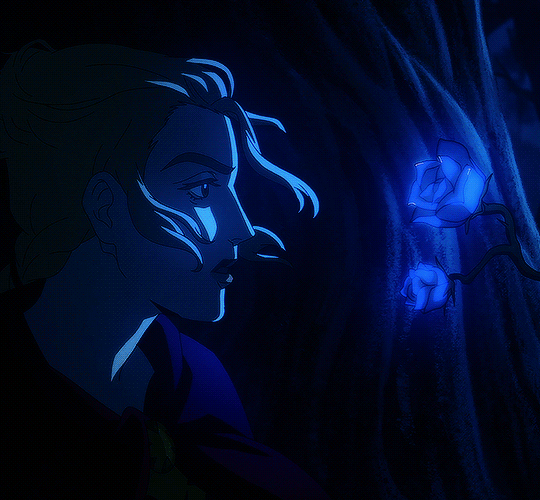
In the ethereal realms of Mount Olympus, where deities resided amidst celestial clouds, lived the twelve Olympians and their cherished human sibling, (Y/N). A child of mortal parentage, (Y/N) possessed an uncommon connection to the gods, born under the shimmering light of a lunar eclipse.
Growing up amidst the grandeur of Olympus, (Y/N) shared an extraordinary bond with each Olympian. Zeus, the thunderous king, would engage in playful wrestling matches, his laughter echoing through the marble halls. Poseidon, lord of the seas, would take (Y/N) on thrilling adventures in his shimmering chariot, the waves roaring beneath their feet.
Athena, goddess of wisdom, guided (Y/N) through labyrinthine libraries, imparting ancient lore and strategic insights. Hermes, the swift messenger, would race with (Y/N) across the celestial heavens, their footsteps leaving a trail of iridescent stardust.
Ares, the god of war, marveled at (Y/N's unwavering spirit, sparing them from harm on the battlefield with his fiery sword. Aphrodite, goddess of beauty, blessed (Y/N) with an irresistible charm that captivated all who beheld them.
Artemis, the huntress, shared her love of the wild with (Y/N), teaching them to track game and wield a bow with precision. Apollo, god of music and prophecy, serenaded (Y/N) with divine melodies, inspiring their creativity.
Hestia, goddess of the hearth, welcomed (Y/N) into her humble abode, offering warm meals and a sanctuary of peace amidst the grandiosity of Olympus. Hades, lord of the underworld, showed unexpected kindness to (Y/N), guiding them safely through his shadowy realm.
As the sun rose and set, casting golden hues across the celestial landscape, (Y/N) reveled in the love and companionship of the Olympians. They became a bridge between the mortal and divine worlds, sharing wisdom and perspective between the two realms.
In the twilight hours, when the stars twinkled like celestial jewels, (Y/N) would often gather with their divine siblings. They would trade stories, laughter, and secrets, their bond unbreakable beneath the ancient night sky.
And so, (Y/N), the cherished sibling of the Olympians, lived a life of extraordinary love and enchantment on the towering heights of Mount Olympus, forever etched into the tapestry of divine history.
291 notes
·
View notes
Text
I have another question (yeah, I know, what a surprise)
what do gods/deities do in their daily life? Or when they're not with us?
Maybe this question is really human-like, because they probably don't work in an office handling paperwork. And it's probably a bit stupid, but I always wondered and idk if there's an actual response in books or somewhere else.
Of course, I know it depends. In some myths, some deities are told to be wandering around the countryside and dealing with plants (Demeter, Persephone, and a lot more) or having parties (Dionysius, Norse deities sometimes, etc). But like, on a daily basis?
I guess Apollo wakes up and guides the sun, but what else does he do? Not saying it is an easy job, but asking if he does something else. Does he visit hospitals from time to time? Or goes to concerts often?
Does Hermes sometimes visit the subway? Is he just going around fetching dead people to guide them to the underworld? Does he go gambling from time to time and give someone too much luck?
Does Hypnos go to a poppy field and he just lays down to take a nap? Does he go around people's nightmares and turn them into soothing dreams? Is he watching when kids have the first dream they remember?
Does Aphrodite go to the beach from time to time to get tan? Does she like to go to perfume shops? Is she making people give compliments to others who feel very bad about their self image that day?
Does Artemis just guide the moon or does she also visit zoos? Is she around for the birth of someone's first baby? Is she there taking care of the animals sacrificed to be our food?
Does Lucifer wander around the stars and fly to see the first light of the morning? And the last light of the evening? Is he reading books that no one has heard of in old libraries? Is he guiding the hand of the artist who draws his first nude portrait?
Does Beelzebub like to smoke and hang out in cemeteries? Is he there when someone saves a bug instead of killing it? Is he checking that all dead beings in the forest decay correctly?
Does Stolas enjoy accompanying biology students to their first field trip to identify rocks? Is he the one who makes people cry of joy when they look at the stars? Does he spend his time reading articles about the use of plants in modern medicine?
Idk, it's nice to think about what they might be doing when they're not with us as their "9 to 5" lol. But is there an actual answer to this or am I just daydreaming too much? 😔
#deity worship#deity work#hellenic polytheism#hellenism#hellenic deities#hellenic worship#lady aphrodite#lord lucifer#hellenic pagan#greek gods#lord beelzebub#lord ares#lord apollo#lord hermes#lord hypnos#lord stolas#lady artemis#theistic satanism#theistic luciferianism#witch community#luciferian witch#pagan witch#witches#witchcraft#witchblr#paganblr#paganism#pagan
275 notes
·
View notes
Photo

Bastet
Bastet is the Egyptian goddess of the home, domesticity, women's secrets, cats, fertility, and childbirth. She protected the home from evil spirits and disease, especially diseases associated with women and children. As with many deities in Egyptian religion, she also played a role in the afterlife.
She is sometimes depicted as a guide and helper to the dead although this was not one of her primary duties. She was the daughter of the sun god Ra and is associated with the concept of the Eye of Ra (the all-seeing eye) and the Distant Goddess (a female deity who leaves Ra and returns to bring transfromation). Bastet was one of the most popular deities of ancient Egypt as she was the protector of everyone's home and family.
Meaning of Bastet's Name
Her name was originally B'sst which became Ubaste, then Bast, then Bastet; the meaning of this name is not known or, at least, not universally agreed upon. Geraldine Pinch claims that "her name probably means She of the Ointment Jar" as she was associated with protection and protective ointments (115). The Greeks associated her closely with their goddess Artemis and believed that, as Artemis had a twin brother (Apollo) so should Bast. They associated Apollo with Horus, the son of Isis (Heru-sa-Aset) and so called the goddess known as Bast ba'Aset (Soul of Isis) which would be the literal translation of her name with the addition of the second 'T' to denote the feminine (Aset being among the Egyptian names for Isis).
Bastet, however, was also sometimes linked with the god of perfume and sweet smells, Nefertum, who was thought to be her son and this further links the meaning of her name to the ointment jar. The most obvious understanding would be that, originally, the name meant something like She of the Ointment Jar (Ubaste) and the Greeks changed the meaning to Soul of Isis as they associated her with the most popular goddess in Egypt. Even so, scholars have come to no agreement on the meaning of her name.
Continue reading...
163 notes
·
View notes
Note
What's your opinion on Hermes in adaptations ? I personally think that, like with other gods, a lot of nuance is often lost.
He's usually just a fun speedy guy in modern vision and we don't really see his status as god of merchants, travels, rhetoric, theft or his role as a psychopomp. It's really a shame, honestly.
He's portrayed as a bit witty, but I'd love to see him more as a trickster god (like in Argos' story), a persuasive talker, a traveler who explores the world and his relationships to mortals and various gods alike.
(like his relationship to youthfulness, being the second youngest Olympian, at odds with Apollo before reaching an agreement, taking care of Pan then Dionysus, some interactions with his mom Maia or his chthonic coworkers, etc...)
Idk I wanted to talk about him a bit instead of complaining about Dionysus for the 100th time this week 🤣. Since Hermes is your favorite god, I thought it'd interest you 😉.
@superkooku thank you for this ask aaaahhhh!!!
Honestly, Hermes as a deity has so many layers of potential when it comes to story writing, and while he is a Certified Happy Go Lucky Extrovert^TM, there are so many aspects of him that aren't just the comedic messenger!!
I could make a list of all the aspects of Hermes I'd personally love to see more in modern media, so here we go:
Hermes' role as the god of thieves and trickery (his darker self, his suave nature, how he killed one of Hera's favorite servants so effortlessly and still remains in her good graces? His caduceus has two snakes- in a dual way representing his slyness along with his role as a protector)
Hermes' role as the god of trade and merchants (you telling me my boy won't be good at haggling prices and owning the market? I need some version of him where he owns the black market or some crazy stuff)
Hermes' role as a psychopomp (and by extension his relationship with his Uncle Hades. What is his relationship with the other chthonic gods? I love what Hades Supergiant did with Hermes/Charon but I long for more! Especially when he's very much there as Persephone's personal escort to and fro the Underworld. Thanatos should not get all the credit for reaping souls and guiding them home. )
Hermes and Maia (extroverted son, introverted mom, so many things we can explore here! How he felt growing up in that cave, his relationship with Arcas who his mother adopted!)
Hermes and Zeus (his aspect of being the god of hospitality!!) (Modern Media might never give us the Zeus-Hermes-Baucis-Philemon adventures but I am still for it always)
Hermes' mental health and depression (+ the bad side of his relationship with his mother and father) (more specifically Lucian Dialogues of the Gods 4, where Hermes states he is the most miserable god in all heaven, working every day and waiting upon Zeus' grander sons from mortal women. Now in my interpretation, Zeus wouldn't be that harsh to Hermes to make him almost like an indentured servant, but reading this dialogue you can really feel his exhaustion from the God of Trade and many other things. We can all relate to the feeling of being brushed off when you're feeling down, and I think this is the least likely aspect of Hermes to be explored since we will be putting him out of the "lucky, carefree" god persona that most put him in)
Hermes and Atlas (going back to Dialogue 4, Hermes mentions being the grandson of Atlas. I find it fascinating bc how does Hermes feel looking at his grandfather? Does he hate his grandfather for siding with Kronos? Does he resent his dad for creating this void for them to not have a relationship? Does he fear that if he steps out of line Zeus could do the same to him? Does he talk to Atlas forced to hold up the sky? Very compelling stuff)
Hermes and Hera (*holds them very tightly* they are the stepmother and stepson duo. Hera can be a certified Apollo-Artemis-Dionysus hater but has almost no hate for Hermes from what I know. There is no retaliation for Argos' death, and we all know Hera can hold a grudge! She milked him once in an obscure myth and that makes him her honorary son alongside Heracles, even appearing to bind Ixion alongside Ares, Hera's biological son. Hermes even makes an effort to deliver all of the invitations to her wedding to Zeus. Sure all of these can be explained by his messenger/servant role, but they seem to have an amicable and fun relationship that most media just writes them down as "Hera hates him" looking at you Blood of Zeus **EDIT: all of these are mostly headcanon-territory, so apologies for that!)
Hermes and Perseus and his role as helper of heroes (his canon bf... people out there shipping Perseus and Medusa when HERMES IS RIGHT. THERE! Perseus is called a beloved of Hermes and I'm sad that people are erasing that in their Perseus retellings. Gifts seem to be a love language for Hermes since he gives him his sandals, sword AND invisibility helm free of charge)
Hermes and Ares / Mercury and Mars (sorry I'm biased the Ares stan in me is coming out forgive me I think Hermes and Ares as a symbiotic relationship is something that can be explored more. The Jar Myth where Hermes saves Ares lets into some of the vulnerabilities Ares has, Lucian Dialogue #1 and the differences with how they view Zeus, war vs diplomacy, both being athletic gods, both being lovers of dogs, and many other things I can pitch for the secret Ares/Hermes fans out there)
Hermes and Dionysus (more modern media of Hermes taking care of his little bro-bro!! To be best buds in the future, that's just so endearing and sweet and we need more interactions between them. Their duality is similar to Ares/Hermes, with the additional madness factor. How would Hermes react to Dionysus' darkest side as his guardian and brother? Also, Hermes would definitely shake up Dionysus' parties. Would they murder together? Maybe. Definitely.)
#hermes#greek mythology#maia#zeus#ares#dionysus#perseus#hera#atlas#hades#charon#thanatos#asks#superkooku#yes i didnt include athena and peitho and his other lovers and him as a Father they're so very fascinating too#just *pinches both his cheeks* I LOVE HIM SO MUCHHH#please chat to me more about him he's my darling angel
78 notes
·
View notes
Text
𖤐 INTRODUCTION 𖤐

I UPDATE ALL MY POSTS IF I FIND NEW INFO. THIS BLOG OF MINE IS SPIRITUAL, IT IS NOT AN AESTHETIC OR FETISH!
Everyone is welcome on my blog, no matter your skin tone, body type, age (please don’t message me if you’re a minor), gender, sexuality, beliefs, nationality, and interests.
DO NOT interact with me or my account if you support anti-abortion, proshippers/or are one, bullying, climate change, war, poverty, terrorism, fetishize serial killers racism, murder, are a hazbin hotel/helluva boss fans, have a nsfw blag, rape/rapists, homophobia, transphobia, sexism, ableist, anti vax, fascists, donald trump, neo-nazi’s, white supremacy, any kind of abuse, TERFs, bestiality, arson, jk rowling, and just overall piss off if you can’t be a decent human being.

ABOUT ME:
My name is Blóðtappi. I’m 19-years-old, Icelandic, my personality type is ENFJ, and I’m an ambivert. I have been a Satanist since Nov 2023 and a witch since Feb 2024. I’ve learnt a lot so far, and still currently am doing research on Satanism and witchcraft. This blog of mine is dedicated to Satanism, Witchcraft, deity and entity info/work.
Currently Working With: Lady Aphrodite, King Asmodeus, Lord Fenrir, Mother Freyja, King Hades, Mother Hecate, Lady Hel, Lord Loki, Mother Lilith, Lord Lucifer, and Queen Persephone.
Will Soon Be Devoted to: ???
Magickal Interests: sigils, crystals, spell work, meditation, divination, runes, and deity and entity work.
Other Interests: metal and rock music, corpse paint, anime, manga, drumming, taxidermy, exercising, vulture culture, and collecting vinyl and CDs.
SOCIALS:
INSTAGRAM: @the.mortuary.witch
PINTEREST: @the_mortuary_witch
TIK TOK: @the_mortuary_witch
POSTS:
SATANISM:
SATANISM INFO
THE 7 FUNDAMENTAL TENETS
PAGAN AND SATANIC HOLIDAYS AND CELEBRATIONS
DIFFERENCES BETWEEN SATANISM, WITCHCRAFT, AND PAGANISM
THE 11 SATANIC RULES OF THE EARTH
WHAT SATANISM DOES AND DOESN’T SUPPORT
THE 9 SATANIC SINS AND THEIR MEANINGS
WITCHCRAFT:
2025 WITCHES CALENDAR
MY ALTARS
THE SABBATS
WAYS TO CELEBRATE THE SABBATS
IMBOLC
OSTARA
BELTANE
LITHA
LAMMAS
MABON
SAMHAIN
YULE
LOW ENERGY YULE ACTIVITIES
WITCHCRAFT INFO
SPELLS
SPELL BAGS
EVERYDAY WITCHCRAFT
TYPES OF WITCHES
TYPES OF HERBS AND SPICES
TYPES OF CRYSTALS
TYPES OF WATER
TYPES OF DIVINATION
INCENSE PROPERTIES
HERB AND FLORA PROPERTIES
GRIMORE IDEAS
WITCHY RED FLAGS
LIMINAL SPACES IN WITCHCRAFT
FRUIT CORRESPONDENCES
CLEANING / REUSING SPELL JARS GUIDE
GRAVEYARD GUIDE
COMMON WITCHY TERMS / TOOLS
WITCHY SYMBOLS AND THEIR MEANINGS
FAMILIARS AND THEIR MEANINGS
CONNECTING WITH NATURE’S ELEMENTS
WHERE TO DRAW SIGILS AND RUNES
CANDLE COLOUR MEANINGS
PLANETARY MAGICK
FULL MOON MEANINGS
MOON PHASES
DAY OF THE WEEK MAGICKAL CORRESPONDENCES
LOW EFFORT / ENERGY WITCHCRAFT
DECEMBER MAGIC CORRESPONDENCES
DEITIES AND ENTITIES:
CONNECTING WITH DEITIES
TYPES OF DEITIES
TYPES OF DEVOTIONAL ACTS
DEITY MASTERLIST (PART ONE)
DEITY MASTERLIST (PART TWO)
IDEAS FOR TALKING TO DEITIES AND ENTITIES
DEITY AND ENTITY PLAYLISTS
DEITY AND ENTITY AESTHETICS
TAROT ASSOCIATED WITH DEITIES AND ENTITIES
MASTERLISTS:
ASMODEUS
ANUBIS
APHRODITE
ARES
APOLLO
ARTEMIS
BAPHOMET
BASTET
BEELZEBUB
CERBERUS
DIONYSUS
DEMETER
FREYJA
FENRIR
HECATE
HYPNOS
HERA
HERMES
HADES
HEL
LOKI
LUCIFER
LILITH
MELINOË
MA’AT
MEDUSA
MARDUK
NYX
ODIN
PERSEPHONE
RAUM
SKÖLL AND HATI
SATAN
SELENE
SANTA MUERTE
THE MORRIGAN
ZEUS
#fyp#fypシ#fypシ゚viral#fyppage#fypage#tumblr fyp#satanism#theistic satanism#theistic satanist#satanist#witchcraft#solitary witch#witch#witches#witchcore#witch community#witchblr#witch blog#deity#deity work#information#about myself#about my blog#dni list#masterlist#helpful#themortuarywitch
189 notes
·
View notes
Text
Artemis + her relationships with other Theoi 🌙🏹🦌
One of the amazing things about Lady Artemis is how versatile her domain is. Here are just some of the prominent theoi she is connected to.
Artemis + Ares 💥
- These two were celebrated together during Kharisteria/Charisteria ('thanksgiving'), which took place on the sixth day of Boedromion.
- Goats were sacrificed jointly to Artemis and Ares for their roles in battle and war.
- Even though Artemis is not technically a 'goddess of war', her role as the (sometimes brutal) hunter gave her an association with battle and death. They were also both patron deities of the Amazons.

Diana of Versailles (original attributed to Leochares)
Artemis + Apollon 🎼
- Perhaps her most famous connection is to that of her twin brother. They are opposites but are also, in a certain sense, two sides of the same coin.
- Apollon is the warmth of the sun, Artemis is the light of the moon. (They also shared the epithet 'light-bringer') They compliment each other while contrasting.
- They are day and night, city and country. They complete a cycle, making them almost inextricably interconnected in myth. Yet they also share domain over hunting, healing, death, and even music.
- The muses, who were led by Apollon, were often seen accompanying Artemis and her nymphs as she danced through the forest. Dance and music were also vitally important in her rituals.
Artemis Hymnia=Of the Hymns
Artemis Hegemone=Leader of Dance/Choir
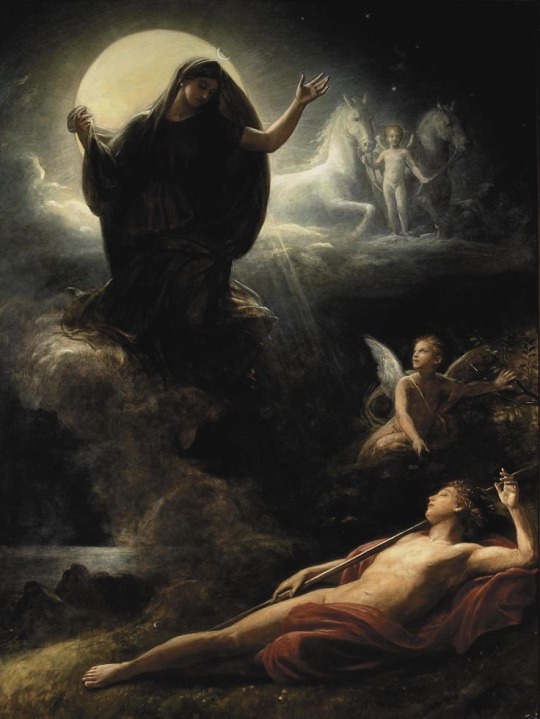
Diana awakening Apollo (Carl Bertling)
Artemis + Dionysus 🐆
- Artemis and Dionysus are both deities of the thin line between us and animals/'beasts.' They symbolize our own wild nature and what it means to succumb to it.
- They historically shared in rituals of 'frenzy', release, and estastic dance. Both are deities of revolutionary liberation and freedom.
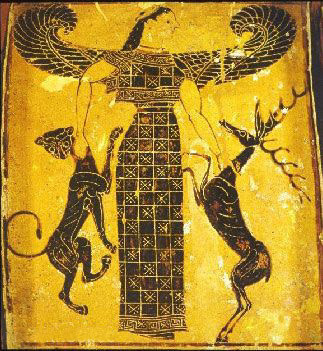
Artemis as 'Potnia Theron' on the François Vase
Artemis + Hekate 🔥
- These two goddesses are so heavily connected that many conflate/synchronize them. They are both deities associated with the night, the moon, and for their roles in protecting the young/children.
- The Roman goddess Diana Trivia is sometimes thought to be a syncretism of Luna/Selene, Artemis/Diana, and Hekate/Trivia.
- They were both known to hold torches and snakes, and some say that it was Artemis instead of Hekate who used her light to guide Demeter to Persephone during her search. Although most still contribute this part of the story to Hekate, it shows how conflated the two goddesses are.
- In some versions of their stories, Iphigenia was 'turned into' Hekate by Artemis. In others, Artemis 'became' Hekate as a companion of Persephone after her descent into the Underworld. Variations of Hekate's name were also epithets of Artemis.
Artemis Hekatê/Hekate = Far-Shooting, Shooter from Afar, or Worker from Afar
Artemis Hekatêbolos/Hecatebolus = Far-Shooting, Far-Darting, or Hundred-Shots
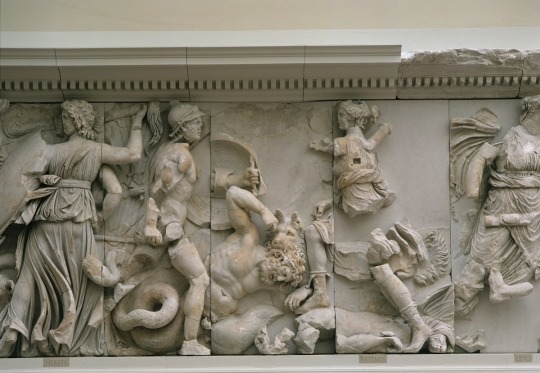
Artemis, Hekate, and Leto from the Pergamon Altar
Artemis + Persephone ����
- It is said that these two were raised together, perhaps with Athena, prior to her descent into the Underworld. They also share domain over nature and vegetation.
- In the Homeric Hymn II to Demeter, (and many other sources) it is said that Artemis and Persephone were picking flowers (sometimes with Athena) when she was taken.
- When Persephone returns from the Underworld, we can only assume that the two sisters and childhood friends are reunited just as she is reunited with Demeter.
- Hekate is also considered to be Persephone's companion in the Underworld. So if one syncretises the two, Artemis-Hekate would be her companion year round!

Diana's Bath (Louis Devedeux)
Artemis + Demeter 🌾
- As well as being deities of vegetation, Artemis is connected to both Persephone and Demeter in their roles in the Eleusinian Mysteries (Hekate also had a prominent role in this tradition).
- The mysterious goddess Despoine, also central to the Eleusinian Mysteries, is thought to be Persephone, Hekate, Artemis, or some syncretism of them.
- The sanctuary of Despoine, which was vital to the tradition of the Eleusinian Mysteries, was in Arcadia. At this sanctuary, Pausanias stated that multiple representations of Artemis could be found; including a 'six foot tall bronze statue' which stood guardian in front of the entrance to the mystery cult.
- A theory states that Demeter is actually the mother of Artemis, while Leto is her 'sister' or 'nurse.' Pausanias claims that "Artemis was the daughter, not of Leto but of Demeter, which is the Egyptian account."

Artemis with a Dog (Munich)
Artemis + Selene 🌕
- It is traditionly stated that Selene is the personification of the moon itself while Artemis is a goddess of the moon.
- At some point, the two were congealed/synchronized as Artemis became more and more heavily associated with the moon. The Roman goddess Diana almost certainly involved syncretism between the two.
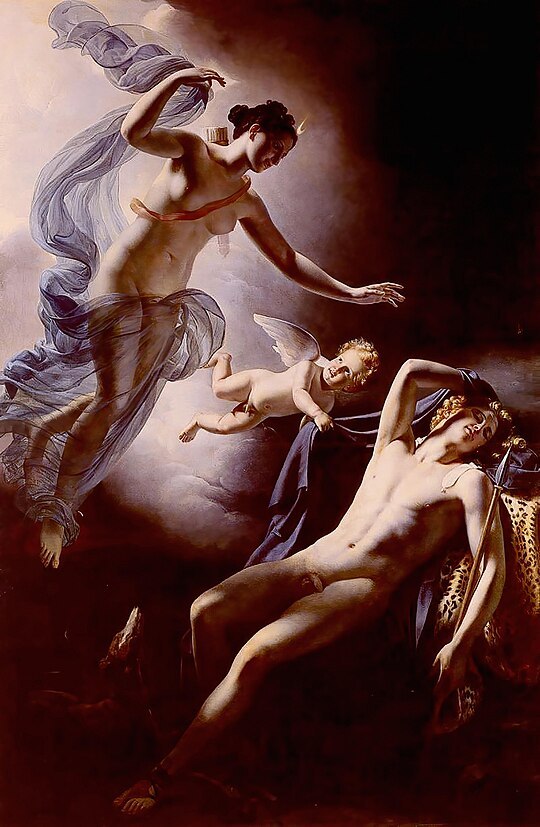
Diana and Endymion (Jérôme-Martin Langlois)
Artemis + Pan 🌿
- Artemis and Pan are both deities of the wild, pastures, woodland, animals, and the country. Rural deities with connections to dance and music, these two have a similar untamed persona.
- Pan gave Artemis a pack of seven hunting dogs as a gift, showing their companionship. Pan also famously had a love affair with Selene, so syncretism between Artemis and Selene also connects her to Pan.
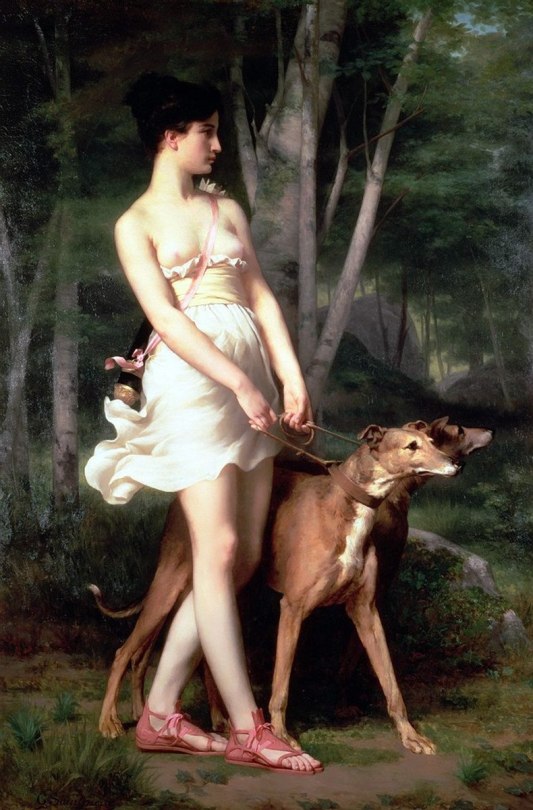
Diana the Huntress (Gaston Casimir Saint-Pierre)
Artemis + Zeus ⛈️
- Artemis has always been a favored daughter of her father. Perhaps their most famous interaction occurs from Callimachus when Artemis, still a child, presents Zeus with a list of requests - including her 'eternal virginity'.
- Zeus is happy to oblige and gives her all that she desired and more. This unconditional love and acceptance illustrates Zeus' affection for his feral daugher of the forest.
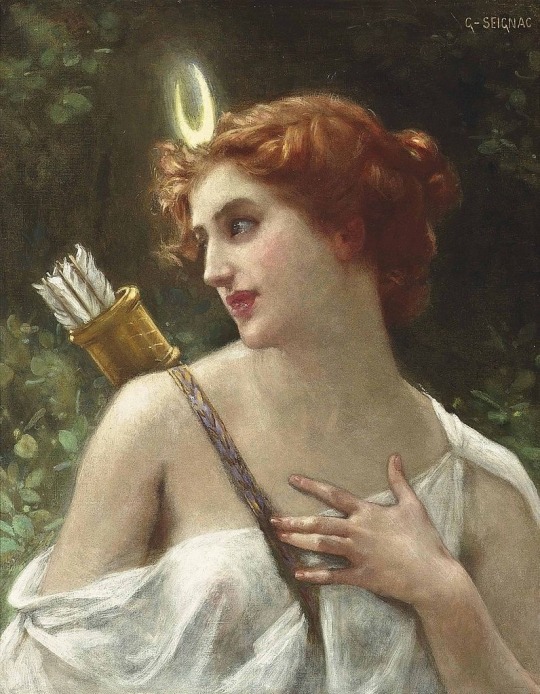
Diana the Huntress by Guilluame Seignac
Artemis + Athena 🦉
- Artemis and Athena share many similar qualities, including their 'chasity' and their choice to remain 'virgins' (in the historical sense of the word).
- As mentioned above, Persephone, Athena, and Artemis are said to have grown up together and were seen picking flowers together.
- As with Artemis' connection to Ares, Athena's domain of war, battle, and death are also connected to Artemis. Their sterness, intensity, and ability to commit violence when deemed necessary connect the two deities.

Diana as Huntress by Bernardino Cametti
Artemis + Hera 👑
- While these two were often in conflict with each other in myth, they still share connections. In historical celebration and ritual, women/girls progressing to adulthood and/or entering into marriage were ceremoniously passed from Artemis' protection to Hera's. They shared space in the context of transitions.
- In addition, Artemis has been heavily conflated with Eileithyia, a goddess of childbirth and daugher of Hera. 'Eileithyia' has even served as an epithet of Artemis.
(From The Theoi Project - theoi.com)
(From She Who Hunts: Artemis: The Goddess Who Changed the World by Carla Ionescu)
#artemis#diana#goddess artemis#artemis goddess#artemis deity#artemis devotion#artemis devotee#hecate#hekate#apollo#apollon#hera#zeus#athena#pan#pan deity#selene#selene deity#demeter#persephone#ares#hellenic pantheon#hellenic polytheism#hellenic gods#hellenic community#hellenic pagan#hellenic paganism#hellenic polytheist#hellenic worship#diana deity
421 notes
·
View notes
Text

All About Lady Hekate
Her Attributes
Witchcraft
Magic
Crossroads
Death and Life
Liminal spaces
Protection of The Home
Necromancy
Spirits
Childbirth and Midwifery
The sea
The stars/Moon
Symbols:
Torches
Snakes, Dragons, Serpents
Dogs especially black
Corvus birds
Fish
Wands
Daggers
Keys
Cats
Moon
Crossroads (three way road)
The number 3, 6, and 9
Hekate’s Wheel or the Stropholos
Skulls or bones
Ferrets
Pomegranates
Any black animals
The color black
Offerings
Libations of wine
Fish
Cakes, breads, any kind of pastries
Herbs like Mugwort, Rue, Belladonna (poisonous), Garlic, Rosemary, Chives, Black Nightshade (Poisonous), Lavender.
Fruits: Pomegranates, Apples, Lemons
Anything related to dogs
Spiritual or magical tools or items
Creating spells and offerings i.e I created a spirit board for Hekate
Spirit communication
Taking care of Children and supporting mothers and soon to be mothers
Epithets (Greek and a Roman title)
Trivia - A Roman title given to Hekate and Diana relating to the crossroads. It’s also said Trivia could’ve been a Roman Goddess on her own.
Brimo - Angry, Terrible one. It’s a title for a god who is showing their scary aspect Hekate, Demeter, Presphone is known for this also male deities like Dionysus. Hekate in this aspect is usually depicted with three heads of animals like dogs, owls, and a serpent but she can take any form that can be terrifying. Usually invoke during rituals and magic spells. Also very good in curse workings, this aspect infamously shows up in the myth of Jason when she is evoke by Medea who is a witch.
Perseis- Destroyer, child of Perses. Hekate’s Father is a Titian Perses who embodies destruction.
Aidônaia - Of the Underworld - Hekate is considered to be a Psychopomp like Hermes she guides souls to the underworld
Kthonia - Of The Earth - many earth deities have this title it can still relate to the underworld but also the physical world like Demeter a earth goddess.
Phosphorus - Light Bringer - Hekate’s main symbols are torches being a guiding light to those who are lost, also to help guide lost souls. Common depiction is how she guided Persephone out of the underworld and guided her so she won’t be lost.
Kourotrophos - Nurse of the young - She is considered to protector of children like how Hera and Artemis is.
Genetyllis - Protector of Births - Hekate is also a midwife goddess and fertility, evoke during births. One myth says she taught Artemis the ways of Midwifery when Leto was giving to Apollo.
Aeneos - Eternal, everlasting.
Trimorphis - Three formed
Trioditis - The three ways or crossroads
Einodia - The one on the Road - Relating to her and the crossroads.
Nyktipolos - Night wandering
Atalos - Tender, Delicate
Skylakagetis - Leader of Dogs
Anassa Eneroi - Queen of those below
Festivals:
Noumenia- Beginning of the new month which is the New Moon. Hekate along with Artemis and Selene are worshipped during this day.
Feast of Hekate is on August 13th where people would bring offerings like honey cakes on the crossroads. The reason being to make sure she won’t summon storms to kill their crops.
In Rome she was honored monthly on the 29th day of the moon.
Tarot Associations
The Moon
The High Priestess
Hierophant
The Hermit
The Two of Swords
General Information
Hekate’s name means “Far-darting” or “who works from afar”. Hekate is the daughter of Perses Titian of Destruction and Asteria Titan of the Stars. It is also said she is also the daughter of Helios and the Oceanid Perse. She is also linked with Circe as her Mother or sister or regular servant to Hekate. As Helios is the father of Circe and Medea who also evokes Hekate a lot in her spells. Helios and Hekate have common myths together.
Hekate is associated with the Full moon and New Moon, stars, and other Cosmic events. She is associated with the sea but most commonly she is associated with earth and the underworld as being a guide to souls to the after life and those coming out. It’s said lost souls follow her along with her nymphs carrying torches. She has black dogs always beside her, it is said you can hear Hekate approching by the howls of dogs.
Hekate is also the protector of the home, keeping a statue of her at the front door will help keep danger away. Protector of liminal spaces and doorways. She can protect a person from curses but she can also help you cast them but she won’t do it unless there’s a good reason. Hekate is goddess of spirits, she can help guide them as I said earlier but also get rid of evil spirits from the home.
At the crossroads is where most likely you’ll find her especially if you need her help. The crossroads are important when it comes to transitions and change and it’s by your choice and of her guidance. But you can also do magic at the crossroads by summoning a spirit or getting rid of one, you can do a simple ritual of banishing a spirit with the item being buried and then you walk away it’s been advised by experienced witches even historians to not turn around after doing the spell. Necromancy is in the context is this, no you’re not summoning the dead back to life or evil spirits, necromancy is simply spirit communication and workings. Of course you’ll be careful with each spirit first encounter with.
Hekate has been a powerful goddess throughout centuries, her origins in Ancient Turkey who was seen as a mother goddess before she was adopted into the Greek Panetheon. She is quite remarkable in Roman religion and even modern day times she is separated from these ancient practices and still a goddess that people go to for all things in life. She is open to all for those who wish to make her involve in your life. Hekate will not be the same for everyone of course, but similarities are true she is very much like a Mother and very protective of her children.
#hellenic polytheism#paganism#witchcraft#hellenic pagan#hellenic community#hellenic worship#hellenic polythiest#helpol#hekate#lady hekate#deity work#deity worship
54 notes
·
View notes
Text
Penelope the Spartan
I’ve been seeing folks in the EPIC fandom bringing up Penelope being Spartan for a variety of reasons, from fighting the suitors to having a more muscular character design to the Warrior AU to thinking Odysseus’s massacre was hot. In particular, her strength of character is often attributed to her upbringing there. So I thought I’d leave behind a little history lesson for y’all!
When reading through mythological sources, you might notice a distinct lack of mention paid to Sparta’s warrior reputation. This is because that culture arose at a specific time due to a specific reign; more specifically, that of King Lycurgus during the 9th or 8th century BCE. That's at least about 400 years after the Odyssey would have occurred and the age of heroes ended. It was his administration that introduced such a martial emphasis to the state. His legendary rule (literally legendary, we don’t know if this guy actually existed and most of the reforms can be dated to a good bit later than he's said to have reigned) transformed the polis into the shape it was by the Classical period, when it began its legendary contention with Athens.

Penelope is also associated in the Epic fandom with Ares because of his connection with Sparta. He appears as her divine guide in the Warrior Penelope AU, and many of the jokes or speculation of him aiding Odysseus's massacre of the suitors include a mention of the princess of his favorite city. But it's interesting to note that he, traditionally held as the patron deity of Sparta, didn't appear to have a strong presence in the city even after its warlike reformation. Among the buildings on their acropolis is a temple to Athena, but nothing to Ares. They primarily venerated Apollo, Athena, and Artemis, and in Homer's day probably had an important cult to Hera as she mentions it as one of her favorite cities. The idea that Ares was their patron seems to have arisen simply from Ares and Athena's mythical rivalry being projected onto the fighting between Sparta and Athens, and from the chained statue of him that Pausanias writes about in the 2nd century AD.
During the Heroic Age, which is the period in which the tales of Greek heroes take place and the Odyssey happens at the very end of, Sparta was a very different city from the one we know. Myths do not depict it as uniquely warlike, nor does it practice its famous comparative gender equality. So Penelope would have been a fairly ordinary princess in terms of her origins. All her fortitude is her own.
#greek mythology#epic the musical#epic penelope#penelope#penelope of sparta#penelope of ithaca#ancient sparta#lycurgus#history#ares#ancient history
46 notes
·
View notes
Text
Ω PJO DEMIGOD HEADCANONS: 🌕 ARTEMIS: Goddess of the Hunt and Wilderness, Archery, Moon, Maidenhood and Childbirth 🏹
author's note: I had a sudden idea about writing some headcanons Camp Halfblood demigods being claimed and what it's like for each respective god and cabin, followed by a small blurb afterwards. Thank you for reading and please like and reblog! The order is not in order of the cabin numbers. [PJO DEMIGOD HEADCANONS MASTERLIST]
You’ve become one of Artemis’ ‘children’ as you joined the hunters of Artemis and became part of the sisterhood.
For the most part, it’s a pretty nomadic way of living. You’re constantly on the move, hunting animals and monsters with your fellow sisters and companions. It's pretty comfy and the tents they set up are great (they also have full blown washrooms somehow, so no need to forgo running water) so it feels like glamping. But every now and again, Artemis takes you guys to stop by Camp Half-blood.
Say what you will, there's something being stationary and sleeping in an actual building, in actual beds.
You see the curious eyes watching you and your group, but they keep their distance given boys are off-limits and girls either look at you with awe or disdain.
Y'know how the Apollo cabin often has archery matches with the Huntresses? Although they don't particularly become any closer, there is some sort of connection between your cabins. Probably because Artemis and Apollo are twins, and Apollo's children don't seem particularly attracted to your group, so there's something there.
You take part and help out with the annual recruitment at the Camp. Teaching other potential maidens about what it's like being a Huntresses. You're told that they always have one interested individual that joins them by the time they leave camp.
Braids are often a common hairstyle among the hunt, aside from ponytails. Being on the move doesn’t allow much time to dwell on hair aside from basic hair care, so keeping it in a braid is often more of convenience. There’s usually a mass hair-washing station and it becomes a group bonding experience. All the hunters help braid your hair and teach you other styles along the way, and it’s not uncommon to see a hair braiding train. This often also leads into storytelling time and devolving much like a sleepover, bringing a certain sense of nostalgia.
You know you’ve become part of the hunters when Artemis asks you to help braid her hair. Your hands will shake and you will stutter, but as she encourages your hands to weave her hair, you feel honoured and the barrier between her and you is less daunting.
Other than Dionysus, people feel envious and are curious what it’s like being around a god so often. Artemis accompanies you on your hunts more often than not, and usually is not around when she has to attend a council with the other Olympians or tend to her nightly duties. It’s a see-saw of perception being around Artemis; on one hand, you’re aware of who she is but on the other hand, when you’re hunting together or when she joins you with the other hunters, you forget she’s a deity.
If you joined in when Zoe is a lieutenant, she is strict but fair. She is the ultimate big sister of the sisterhood. She may seem a bit cold to you but as she helps guide your shooting stance and gives you tips, tells you to zip up your parka or checks your supplies, you know she cares for you like a sister. In fact, you notice she seems more at ease as she looks after you and your sister…it makes you think if she had biological sisters.
When Thalia is now the lieutenant, it takes some time to get used to. There’s a bit of friction and gap, since Zoe was in that position for over 2000 years. However, Thalia is confident and has the qualities of a leader, so her stumbles become sprints. She is different from Zoe in how they bond with the sisterhood, but if Zoe was the cool, proud sister, then Thalia is the fun, laughable sister that wouldn’t hesitate to give you a noogie.
You looked upon the silver lady, her entourage of people behind her. The moon was full behind her head, bestowing a glow on her and you were just in awe to be in her shadow.
A tall and graceful girl stepped forward and she regarded you with a pointed look. “If you wish to join our lady and our hunt, you must pledge yourself from romantic love and swear loyalty to Lady Artemis and our sisterhood.”
You nodded as she nodded back. “Recite this oath: I pledge myself to the Goddess Artemis. I turn my back on the company of men, accept eternal maidenhood, and join the Hunt.”
You recited this pledge and the girl with moonlike qualities smiled. “I, Artemis, accept this pledge. Welcome sister to the Hunt. As long as you remain as one of my Hunters, and are not slain in battle, you will not die under my watch.”
The other hunters cheered for you as you nodded. The other girl stepped forward with a warmer smile and held out her hand to you.
“My name is Zoe Nightshade, lieutenant of Lady Artemis. Welcome to our sisterhood.”
#pjo fanfic#pjo imagine#percy jackson and the olympians imagines#pjo#pjo imagines#pjo x reader#demigod#demigod imagines#demigod h/cs#demigod headcanons#demigod reader#Artemis#hunters of artemis#zoe nightshade#pjo reader insert#cabin 8#zoe nightshade imagine#artemis cabin#percy jackson and the olympians imagine#percy jackon and the olympians
259 notes
·
View notes
Text
March 2024 witch guide
Full moon: March 25th
New moon: March 10th
Sabbats: Ostara-March 19th
March Worm Moon
Known as: Crow Moon, Eagle Moon, Goose Moon, Hrethmonath, Lenting moon, Lentzinmanoth, Moon of Snowblind, Moon of Winds, Plow Moon, Sap Moon, Seed Moon, Sore Eyes Moon, Storm Moon, Sugar Moon & Wind Strong Moon
Element: Water
Zodiac: Pisces & Aries
Nature spirits: Air & water spirits & Mer-people
Deities: Artemis, Astarte, Athena, Cybele, Isis, Luna & Minerva
Animals: Boar, cougar & hedgehog
Birds: Sea crow & sea eagle
Trees: Alder, dogwood & honeysuckle
Herbs: Apple blossom, broom, high John root, Irish moss, pennyroyal, wood betony & yellow dock
Flowers: Daffodil, jonquil & violet
Scents: Apple blossom & honeysuckle
Stones: Aquamarine, bloodstone, jasper, opal &topaz
Colors: Pale-green, red, violet, yellow & white
Energy: Balance, beginnings, dream work, energy breaking into the open, exploring, fertility, inner development, karma, prosperity, spirituality, success & truth seeking
For many years, it was thought that the name "Worm Moon" referred to the earthworms that appear as the soil warms in spring. This invites robins and other birds to feed—a true sign of spring.
However, more research revealed another explanation. In the 1760s, Captain Jonathan Carver visited the Naudowessie (Dakota) and other Native American tribes and wrote that the name Worm Moon refers to a different sort of “worm”—beetle larvae—which begin to emerge from the thawing bark of trees and other winter hideouts at this time.
March’s full Moon often plays a role in religion, specifically in Christianity, this Moon is known as the Lenten Moon if it is the last full Moon of the winter season (i.e., if it occurs before the spring equinox) or as the Paschal Full Moon if it is the first full Moon of spring (i.e., if it occurs after the spring equinox).
Ostara
Known as: Alban Eiler, Lady Day & Spring/Vernal equinox
Season: Spring
Symbols: 8-spoked wheel, butterflies, chicks, decorated baskets, eggs, feathers, jellybeans, lambs, rabbits, seeds, shamrocks, spring flowers & sunwheels
Colors: Green, indigo, light blue, pastels, pink, red & yellow
Oils/Incense: African violet, florals, ginger, jasmine, lotus, magnolia, rose, sage & strawberry
Animals: Cormorant, hare, hawk, rabbit, sheep, sparrow & swallow
Mythical: Dragon & Unicorn
Stones: Amethyst, aquamarine, bloodstone, moonstone, red jasper & rose quartz
Food: Dairy foods, eggs(hard boiled), fruits, honey, honey cakes, leafy greens, vegetables, pine nuts, pumpkin, sunflower seeds, sprouts & waffles
Herbs/Plants: Acorn, cinquefoil, dogwood, ginger, Irish moss, olive, strawberry & woodruff
Flowers: Celandine, crocus, daffodil, dandelion, Easter lily, jasmine gorse, honeysuckle, hyssop, iris, jonquil, linden, narcissus, peony, snowdrop, tansy & violet
Goddesses: Aphrodite, Ariadne, Artemis, Athena, Coatlicue, Cybele,Demeter, Diana, Eos, Eostre, Flora, Gaia, Hera, Idunn, Iris, Ishtar, Juno, Minerva, Persephone, Venus & Vesta
Gods: Adonis, Attis, Celi, Cernunnos, Coel, Dagda, Dalon ap Landu, Dumuzi, Green Man, Lord of the Greenwood, Mithras, Odin, Osiris, Ovis & Pan
Issues, Intentions & Powers: Agriculture, balance, beauty, fertility, growth, life, love & rebirth/renewal
Spellwork: Air magick, fertility, new beginnings & water magick
Activities:
• Go on a hike/walk & look for signs of spring
• Add Ostara symbols to decorate your altar space
• Plant vegetable &/or flower seedlings
• Decorate eggs with bright colors
• Set your intentions for the weeks/months ahead
• Start a new class or hobby
• Create eggshell candles
• Make plans & new routines for the future
• Participate in rituals & ceremonies that connect you with energy & the life force of nature
• Have a feast with your friends &/family with sprouts & leafy greens
• Bake hot cross buns or lavender/lemon flavored treats
• Clean & de-clutter your home
• Try a re-birthing/ renewing ritual
• Bring fresh flowers or plants into into the home
• Host a spring & floral themed tea party
• Make egg based food dishes & desserts
This holiday marks the Spring Equinox, which happens before March 19-22. It is the second of three spring celebrations (the midpoint between Imbolc and Beltane) during which light & darkness are again in balance, with light on the rise. It is a time of new beginnings & of life emerging further from the grips of winter.
There is much debate regarding the origins of Ostara due to the lack of primary sources about this sabbat. One theory is the name of Ostara came from the Anglo-Saxon goddess Eostre. Another theory is that Eostre is more of a localized goddess in Kent County, England. Despite the questions of her origins, Eostre is associated with modern-day Pagan traditions of Ostara.
There is no evidence that the ancient Greeks or Romans celebrated Ostara, although they did celebrate their own spring festivals, such as the Roman festival of Floralia & the Greek festival of Anthesteria. It was a time to honor the returning sun, fertility & rebirth.
Related festivals:
• Nowruz- March 19th
Nowruz marks the first day of spring & renewal of nature. It is celebrated on the day of the astronomical vernal equinox. It is also celebrated as the beginning of the new year by people all around the world for over 3,000 years in the Balkans, the Black Sea Basin, the Caucasus, Central Asia, the Middle East & other regions.
It promotes values of peace & solidarity between generations & within families as well as reconciliation & neighbourliness. Nowruz plays a significant role in strengthening the ties among peoples based on mutual respect & the ideals of peace and good neighbourliness.
Traditional customs of Nowruz include fire & water, ritual dances, gift exchanges, reciting poetry, symbolic objects & more; these customs differ between the diverse peoples & countries that celebrate the festival.
• Holi- March 25th
Holi is a popular & significant Hindu festival celebrated as the The festival of colors, Love &Spring. It commemorates eternal and divine love of the deities Radha & Krishna. Additionally, the day signifies the triumph of good over evil, as it celebratess the victory of Vishnu as Narasimha over Hiranyakashipu. Holi originated & is predominantly celebrated in the Indian subcontinent, but has also spread to other regions of Asia & parts of the Western world through the Indian diaspora.
Holi also celebrates the arrival of Spring in India, the end of winter & the blossoming of love. It is also an invocation for a good spring harvest season. It lasts for a night & a day, starting on the evening of the Purnima (full moon day) falling on the Hindu calendar month of Phalguna, which falls around the middle of March in the Gregorian calendar.
• Easter- March 31st
also called Pascha or Resurrection Sunday is a Christian festival & cultural holiday commemorating the resurrection of Jesus from the dead, described in the New Testament as having occurred on the third day of his burial following his crucifixion by the Romans at Calvary c. 30 AD. It is the culmination of the Passion of Jesus Christ, preceded by Lent (or Great Lent), a 40-day period of fasting, prayer, & penance.
Easter traditions vary across the Christian world & include sunrise services or late-night vigils, exclamations & exchanges of Paschal greetings, flowering the cross & the decoration and the communal breaking of Easter eggs (a symbol of the empty tomb) among many others. The Easter lily is a symbol of the resurrection in Western Christianity traditionally decorates the chancel area of churches on this day & for the rest of Eastertide. Additional customs that have become associated with Easter & are observed by both Christians & some non-Christians include Easter parades, communal dancing, the Easter Bunny & egg hunting.
Other Celebrations:
• Festival of Luna- March 31st
Is a feast day honoring the Goddess Luna who is seen as the divine embodiment of the Moon.
The Temple of Luna was a temple on the Aventine Hill in Rome, dedicated to Luna, the moon goddess. Its dedication was celebrated on March 31st, thus the celebration.
According to Tacitus, it was built by king Servius Tullius. However, the first confirmed reference to a temple to Luna dates to 182 BC & refers to one of its doors being knocked off its posts by a miraculous blast of air & shot into the back of the Temple of Ceres. That account probably places the temple at the north end of the hill, just above porta Trigemina. The temple was struck by lightning around the time of the death of Cinna, as was the temple of Ceres. After the destruction of Corinth, Lucius Mummius Achaicus dedicated some of his spoils from the city to this temple. It was destroyed in the Great Fire of Rome in 64 AD & not rebuilt.
Sources:
Farmersalmanac .com
Llewellyn's Complete Book of Correspondences by Sandra Kines
Wikipedia
A Witch's Book of Correspondences by Viktorija Briggs
Encyclopedia britannica
Llewellyn 2024 magical almanac Practical magic for everyday living
#correspondences#sabbat#wheel of the year#ostara#Worm Moon#witch community#witchblr#wiccablr#paganblr#witchcraft#witches of tumblr#tumblr witch community#tumblr witches#full moon#witch guide#witch tips#traditional witchcraft#spellbook#grimoire#book of shadows#beginner witch#baby witch#full moon magick#witchcore#GreenWitchcrafts#pagan#wicca#witch#witchy tumblr#spells
243 notes
·
View notes
Text
January 2025 Hellenistic Festivals and Holy Days

Here is a quick guide for the calendar:
Modern Julian Calendar Date
(Attic Lunar Calendar Date )
🏛 Holy Day 🏛
🥂 Festival 🥂
Resources are in the bottom of the calendar!
Wednesday January 1 (1 Gamelion)
🥂 Festival 🥂
Noumenia
The most important of the three recurring monthly festivals. This is the first day of the Attic month of Gamelion. Traditionally Zeus, Apollon Noumenios, Apollon Agyieus, Artemis, Hermes, Selene, personal matrons and patrons and other deities you and your family are close to are traditionally honored.
Thursday January 2 (2 Gamelion)
🥂 Festival 🥂
Agathos Daimon
In honor of the Agathos Daimones who look after you and your family. Ancestor veneration may also be done on this day.
Friday January 3 (3 Gamelion)
🏛 Holy Day 🏛
Sacred to Athena
Saturday January 4 (4 Gamelion)
🏛 Holy Day 🏛
Sacred to Aphrodite, Herakles, Hermes and Eros
Sunday January 5 (5 Gamelion)
Monday January 6 (6 Gamelion)
🏛 Holy Day 🏛
Sacred to Artemis
Tuesday January 7 (7 Gamelion)
🏛 Holy Day 🏛
Sacred to Apollo
Wednesday January 8 (8 Gamelion)
🏛 Holy Day 🏛
Sacred to Poseidon and Theseus
Thursday January 9 (9 Gamelion)
🏛 Holy Day 🏛
Sacred to Helios, the Muses, Rhea
Friday January 10 (10 Gamelion)
Saturday January 11 (11 Gamelion)
🥂 Festival 🥂
Libation to Hera
This is a Hellenion specific event and those who wish to join may.
"On the second Saturday of each month members of Hellenion pour a libation to one of the Olympians on the same day, from wherever they may be, with whomever may join them, around the world. In this way, whatever else we do to celebrate Hellenic occasions, we are united in doing the same action on the same day. In January, we honor Hera"
Sunday January 12 (12 Gamelion)
🥂 Festival 🥂
Lenia
Lenia is a four day festival honoring Dionysus and the maenads. Eat, drink, be merry! Have a girls night out. Recite Orphic Hymns 30 and 45, or Homeric Hymns 1, 7, and 26. Put on a dramatic play or do a dramatic reading of something.
Monday January 13 (13 Gamelion)
🥂 Festival 🥂
Lenia
Lenia is a four day festival honoring Dionysus and the maenads. Eat, drink, be merry! Have a girls night out. Recite Orphic Hymns 30 and 45, or Homeric Hymns 1, 7, and 26. Put on a dramatic play or do a dramatic reading of something.
Tuesday January 14 (14 Gamelion)
🥂 Festival 🥂
Lenia
Lenia is a four day festival honoring Dionysus and the maenads. Eat, drink, be merry! Have a girls night out. Recite Orphic Hymns 30 and 45, or Homeric Hymns 1, 7, and 26. Put on a dramatic play or do a dramatic reading of something.
Wednesday January 15 (15 Gamelion)
🥂 Festival 🥂
Lenia
Lenia is a four day festival honoring Dionysus and the maenads. Eat, drink, be merry! Have a girls night out. Recite Orphic Hymns 30 and 45, or Homeric Hymns 1, 7, and 26. Put on a dramatic play or do a dramatic reading of something.
Thursday January 16 (16 Gamelion)
Friday January 17 (17 Gamelion)
Saturday January 18 (18 Gamelion)
Sunday January 19 (19 Gamelion)
Monday January 20 (20 Gamelion)
Tuesday January 21 (21 Gamelion)
Wednesday January 22 (22 Gamelion)
Thursday January 23 (23 Gamelion)
Friday January 24 (24 Gamelion)
Saturday January 25 (25 Gamelion)
Sunday January 26 (26 Gamelion)
Monday January 27 (27 Gamelion)
🥂 Festival 🥂
Theogamia
This is the anniversary of the marriage of Zeus and Hera. Give honor to current relationships, plan a marriage, or look back on a wedding! This is a day to honor your partner and perhaps your parents' marriage. This a good day to recite Orphic Hymn 15 to Zeus and 16 to Hera or Homeric Hymn 12 to Hera.
Tuesday January 28 (28 Gamelion)
Wednesday January 29 (29 Gamelion)
Thursday January 30 (30 Gamelion)
🥂 Festival 🥂
Hekate's Deipnon
This festival happens at the darkest part of the month. At this time, prepare your home for a new month. Purify the self, the home, and get affairs in order. This is also a good time to donate food or money or volunteer. Think about what you don't want to bring into the next month (bad energy, bad food in your fridge, a dirty home)... and fix it!
Friday January 31 (1 Anthesterion)
🥂 Festival 🥂
Noumenia
The most important of the three recurring monthly festivals. This is the first day of the Attic month of Gamelion. Traditionally Zeus, Apollon Noumenios, Apollon Agyieus, Artemis, Hermes, Selene, personal matrons and patrons and other deities you and your family are close to are traditionally honored.
Resources:
#hellenism#hellenic polytheism#hellenic pagan#hellenic calendar#thehelpfulhellenist#hellenic worship#hellenistic#ancient greece#apollo#zeus#hera#hekate#dionysus#lenia#theogamia#calendar
43 notes
·
View notes
Text
Neo's Hecate = The Triple Goddess
Trivia is the Roman name of Hecate, Goddess of witchcraft, crossroads and ghosts. Neopolitan is Roman's Hecate, so her birth name is Trivia. Is that really all there is?

Obviously not. Or at least, Neo's allusion to Hecate can be read in multiple ways. Sure, it might have been an unplanned reference, but by this point (either willingly or not) Neopolitan has grown into Hecate's role. So, let's analyze ice-cream's girl allusion to better understand her story, with a focus on volume 9.
WHO IS HECATE?
Hecate is a Greek Goddes, who is later adopted by the Romans with the name of Trivia. Her origin is probably more ancient than Greek culture, though. In short, she is a foreign deity, who gets integrated into Greek religion. Similarly, Neopolitan is an unplanned character shoved into the narrative. However, she finds her place in the story and grows into herself.
Here are some of Hecate's most famous attributes.
Hecate is the Goddess of crossroads and magic. In particular, she is the master of darkness and the queen of ghosts to the point she is linked to nechromancy. She also rules over demons called Empusas, who are half woman and half beast (either a cow or a dog usually). They eat human blood and are linked to fire. Finally, Hecate is a psychopomp deity (like Hermes/Mercury), so she moves freely among Earth (human world), Olympus (world of the gods) and Hades (world of the deads).
Hecate is often depicted with three bodies and three heads:
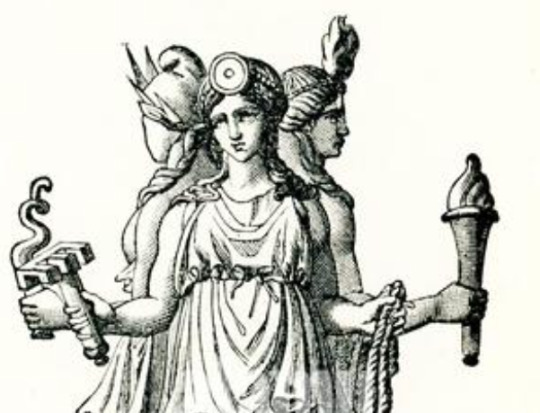
She holds torches and keys, which are symbolic of her ability to guide people in the underworld and to travel among dimensions. Sometimes, she can appear as a dog, which is her sacred animal.
Hecate is one of the Goddesses associated to the moon. In particular, she is the falling moon to Artemis's crescent moon and Selene's full moon. According to other traditions, she is a part of Artemis/Diana. This Goddess is the Moon in the Sky, Artemis on Earth and Hecate in the Underworld. Whatever the case, both Artemis and Hecate have a triple nature to them.
This triple nature makes Hecate an example of Triple Goddess in modern Neopagan religions. The Triple Goddess is the archetype of a female deity linked to the three phases of a woman's life. Youth (Maiden), Maturity (Mother) and Old Age (Crone). Her male counterpart is the Horned God.
As you see, Hecate is hard to define. Just like Neo. Both are ambiguous and difficult to grasp. Still, let's try to understand ice-cream girl better by using this mysterious Goddess. Let's focus on three things (obviously :P):
Hecate's link to the number 3 and how it is used in Neo's story
Hecate and Artemis's bond and how it mirrors Neo and Ruby's
Hecate's imagery and attributes and what they mean for Neo
The first is an analysis of Neo's interiority (microchosm). The second explains Neo's role in the story (macrochosm). The third offers a synthesis and a conclusion (balance).
RULE OF THREE (MICROCHOSM)
Hecate is known for her three heads and three bodies. Neo is a normal human, but the number 3 still comes up in her design:

Pink, white and brown. Strawberry, vanilla and chocolate. The three flavours of the Neapolitan ice cream. The three sides of Neo's self:
We are ruled by thirds. In fashion we compare no more than three colors. Our personalities are defined by the id, the ego and the super-ego- always warring vying for control. But our goal is harmony. Balance. (Roman Holiday, chapter 13)
According to Freud, the human mind is made of three parts. The id is where fear and wishes lie. It is a primitive and instinctive force. The superego is society’s expectations. It is where morality and ideals are. The ego is what balances the other two parts. It mediates between wishes and duties.
As per Roman Holiday, Neo is a combination of Neopolitan (pink), Vanille (white) and Trivia (brown). So, Neo's color scheme is a metaphorical representation of id, superego and ego:
Pink represents the id - Neopolitan is Trivia's pink imaginary friend. She embodies everything the child is forced to repress, like her pink eye and her wish for freedom.
White represents the superego - Vanille is Trivia's surname and a shade of white. The Vanilles want their daughter to fit into society and despise her disability, which makes her "odd".
Brown represents the ego - Trivia has brown hair, wears brown clothes and a brown contact lens. She is conflicted between her parents' expectations and her own wishes.
In her childhood, Trivia is unbalanced because her family forces her to repress her id. She cancels her pink side and projects it on her imaginary friend Neopolitan. So, Trivia undergoes a transformation and claims this part of herself back:
As the old saying went, “You can’t put the moon back together”. At times you had to destroy something to make something even better in its place. When Mama had shattered Neopolitan in front of their burning house, Trivia finally understood that she had been broken all along. Losing her friend was Trivia’s first step toward putting herself back together and embracing her true, best self. (Roman Holiday, chapter 11)
She re-arranges herself and her three parts:
Pink becomes the color of Neo's ego (her truest self). She stops hiding her eye and dyes half of her hair pink. Similarly, she embraces her Neopolitan persona more.
Brown becomes the color of the superego. It is a color linked to Neo's female authority figures like her mother (Carmel) and her teacher (Beatrix Browning). It is still present in Neo's color scheme, but much reduced. Similarly, Trivia is still there, but feels more like a mask than Neo's real self.
White becomes the color of the id. It is the color of Neo's family name, which she sheds. However, Neo still loves her parents, so her semblance dyes a lock of her hair white as an unconscious response to their death.
Roman Holiday is the story of Trivia Vanille's death and Neopolitan's birth:
As far as she was concerned, Trivia Vanille was buried under that mess, too. Neopolitan was the sole survivor. (Roman Holiday, chapter 26)
Neo leaves behind her parents and their strict rules to become a living manifestation of the id:
She just wanted to do whatever she wanted. And for the moment, what she wanted was to help Roman set the world on fire. (Roman Holiday, chapter 26)
Neopolitan does whatever she wants, even if it hurts others. She embraces her deepest wishes and chaotic emotions. This is the character we meet at the beginning of RWBY.
Well, Neo's arc in the series is to discard this person and to become someone new once again. After all, Neopolitan's name is linked to renewal and transformation. "Neopolitan" comes from Naples, which means "new city" (neo + polis). Naples's fantastic origin itself is a story of death and rebirth. According to the legend, this Italian city is born from a Siren, who dies for love. Her body transforms into the city and gives new life.
Similarly, Neo is a character able to be reborn countless times (neo = new + poly= many). So is Hecate, whose name may refer to the Greek number 100, as the Goddess is said to have one-hundred forms.
Our Neo/Hecate is then a multifaceted force, who goes through destruction just to embrace creation.
Neo's change in the series starts with a loss:
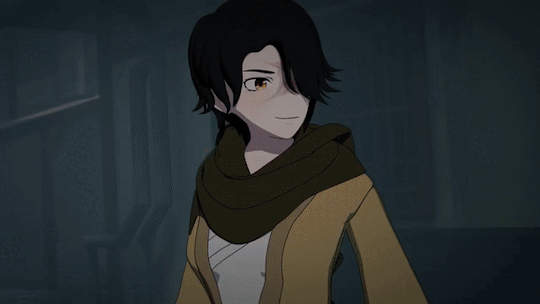
She loses both Roman and her inner balance:
There was one thing To help escape the misery And now it's all disarrayed You took my whole life away You sent me back to nothing Now you'll pay
So, she needs to rebuild herself once again:
We must live with balance But balance is blind (Lost her world) Vengeance is a riptide In a fairy tale, she'll find Inside A new me, I'm ready But who will I find? Inside I've gotta let go but could I lose my mind?
Volume 9 is where this inner transformation takes place. This time the new found harmony among id, superego and ego is not described by Neo's three colors. Rather, allusions are used.
In the Ever After, Neo is associated to three different Wonderland / Through the Looking Glass characters:
The Hatter, who represents the id
The Cheshire Cat, who represents the superego
The Jabberwocky, who represents the ego
THE HATTER - THE ID
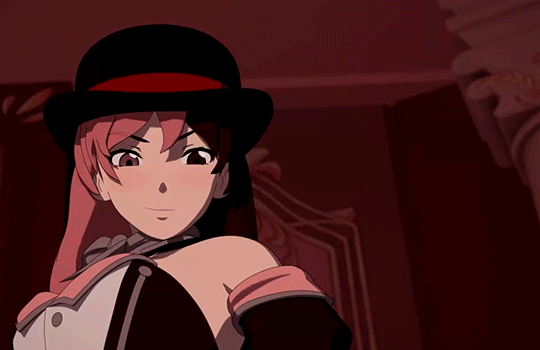
“Well, I'd hardly finished the first verse," said the Hatter, "when the Queen bawled out 'He's murdering the time! Off with his head!'" "How dreadfully savage!" exclaimed Alice. "and ever since that," the Hatter went on in a mournful tone, "he wo'n't do a thing I ask! It's always six o'clock now.”
The Hatter is a Wonderland and Through The Looking Glass character. He is famous for the Mad Tea Party, where he, the March Hare and the Dormouse chat with Alice. The original book reveals that the Hatter "killed time" while singing, so Time refuses to run normally for him and his friends. As a result, they are stuck in an eternal tea-party, as it is always tea-time for them. In the 1951 Disney movie, instead, he celebrates Alice's unbirthday.
Neopolitan has been stuck in time since Roman's death. She can't move on, so she focuses all her energies on revenge:
So close to closure The one thing you need Underneath a monument with a dedicated plea
Killing Ruby becomes Neo's One Thing to the point she organizes a special tea party of her own:

Ruby's unbirthday party, to be precise:
Cinder: And you… should have never been born…
Where she can dissolve Little Red in a cup, as if she were a sugar cube:
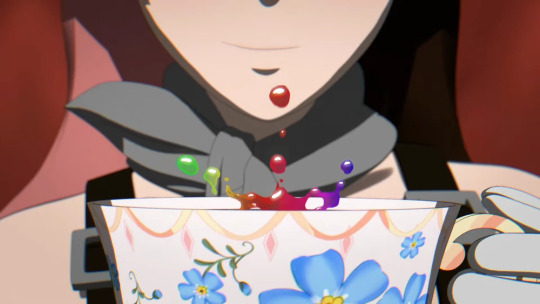
Kill for kill Eye for eye Blood for blood It's time to die Retribution tastes so sweet
The Hatter is a hostage in his tea party and Neo is a prisoner of her revenge. Both are consumed by their inability to go on. Both have killed time and can't face their future.
In Neo's case, the reason why she murders time is pretty clear. It is a coping mechanism to avoid grief:
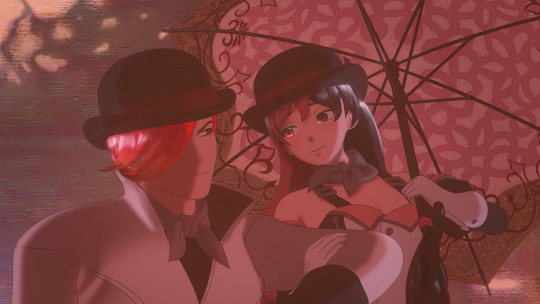
In Wonderland, the Hatter can drink tea at every hour. In her fantasy world, Neo can stay with Roman forever:
Neo-Roman: Y’know once Neo realized where she was, everything changed. Always loved the idea of a place to run away from it all. Do whatever you want. I offered that to her back on Remnant.
This is also why the first thing Neo does after landing in the Ever After is to evolve Overactive Imagination and to kill the Jabberwalker:
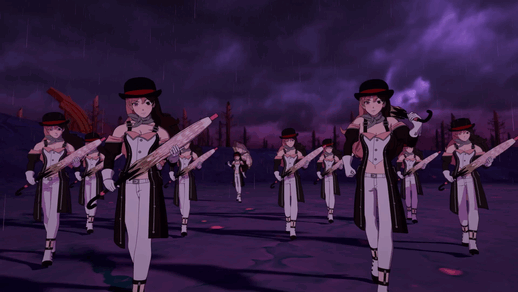
The creature is symbolic of death, as they kill Afterans permanently. So, Neo metaphorically negates her grief (the Jabberwalker) through illusions (her semblance).
At the same time, Neo enters the Ever After and gives in to her id. She has her desires and instincts control her completely. She loses all filters:
(Then suddenly) Scratched through the surface And you've found a key Unlocking what you thought was safe inside a box But it's somehow been set free (Finally)
Overactive Imagination's evolution is a physical representation of this psychological process. Neo spirals throughout Mistral and Atlas, but in volume 9 she hits rock bottom and stops acting rationally. She becomes the incarnation of her anger, which manifests through her semblance. Her illusions are typically silent. However, in the Ever After they speak, as Neo is letting her inner voices out of the box:
Say something real Do you only speak in riddles, chatterbox? I'm waiting for your ugly mouth to spit it out
This is why she becomes a chatterbox. She tries to communicate through her creations.
In particular, she makes an imaginary Roman (the Hatter), who looks and sounds like the real deal. He becomes the dominant voice in Neo's mind and speaks to and for her. His presence highlights Neo's inability to accept Roman's death. She hides in a lie. Just like Trivia used to cower behind her imaginary friend Neopolitan. As a child, Trivia can't accept Neo is a part of her. As an adult, Neo can't accept Roman isn't with her anymore. In this way, Neo's first real human connection gets reduced to an imaginary friend. This is the tragedy of Neo's adventure in the Ever After.
All happens because Neo surrenders herself to the id (her inner world). Still, it can't last forever. The id is a powerful source of energy and drive, but it is also destructive. So, Neo self-consumes until she has nothing left:
Neo-Roman: (voice in Neo’s head) You’ve finally done it! Little Red’s gone. With your Semblance stronger than ever now, we can take over this whole absurd place! Why not? Offing Little Red can’t be all you wanted… Right?
She puts so much into destroying Ruby, that she ends up empty. A vessel for others to take advantage of.
Curious Cat: You’ve lost something most important, haven’t you? And now you have nothing left. How delightful! An empty host, perfect for me to fill.
THE CHESHIRE CAT - THE SUPEREGO
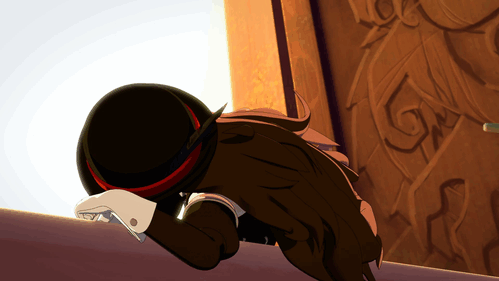
The Cheshire Cat appears twice in Alice's Adventures in Wonderland. The first time, he guides Alice at a crossroad and points her towards the March Hare's house. The second time, he appears at the Queen of Heart's croquet game as a giant head. The Queen and King are offended by his presence and want to behead him. Still, he is a head without a body, so the execution of this death sentence is complicated. Eventually, he simply fades away and disappears.
The character is inspired by the saying "grinning like a Cheshire Cat", whose origin is unknown. Among the many hypothesis, there is one about a grinning cat-shaped cheese. The cheese was cut from the tail, so that the last part eaten was the head of the smiling cat.
In RWBY, the character who alludes to the Cheshire Cat is not Neo, but the Curious Cat. Still, Neo and the Cat's stories are intertwined, as they destroy each other. The Cat possesses Neo and Neo kills the Cat.
Both characters eat and get eaten. They eat like the two wolves of Ruby's Little Red Riding Hood. They get eaten like the cat-shaped cheese, until only a floating head remains. A head separated from the body. A mind detached from reality:
“We’re all mad here. I’m mad. You’re mad.” “How do you know I’m mad?” said Alice. “You must be,” said the Cat, or you wouldn’t have come here.”
Neo and the Cat are mad, so they meet in the Ever After. However, their madnesses are opposite:
Neo loses herself in fantasy (the Ever After) and runs away from the real world (Remnant). She lets her unconscious feelings (id) run wild.
The Curious Cat is trapped in fantasy (the Ever After) and wants to reach the real world (Remnant). They are consumed by an imposed purpose (superego):
Curious Cat: I’m not like the other Afterans here, I’m cursed with curiosity. I need to know everything!
Blacksmith: A terrible thing to have a broken heart… And there’s nobody to send them (the Cat) back to the Tree for repair.
So, Neo and the Cat are foils, which is why they share the song Chatterbox. Both blabber non-stop. However, Neo's illusions speak her truest self. The Curious Cat instead uses smart words to hide their real intentions. Neo shows her inner beast (the shadow), while the Cat wears a mask (persona). So, Neo is the embodyment of the id and the Cat is her estranged superego. They are an external force, who comes and takes control of Neo's life:

The possession is a metaphor of Neo's state of mind. She goes from moving many characters around to becoming a controlled puppet. From shouting to radio silence. This switch is conveyed through the Curious Cat speaking through and for her.
This is Neo's nightmare, as her life is a struggle to be heard. Among other things, Neo refuses devices that make her sound robotic. She dislikes artificial voices because they sound fake to her. And yet, the Curious Cat forces Neo to speak their words. The Cat becomes Neo's new voice.
This is the result of Neo losing her inner drive:
NeoCat: She has no attachments to your world. Nothing to return to.
She is left with no wishes nor fears. She is a living id, who transforms into a walking superego. However, both extremes are wrong. A person is made of both her id and her superego. Both parts are needed to make an individual, which is why Neo is asked to face herself once more:
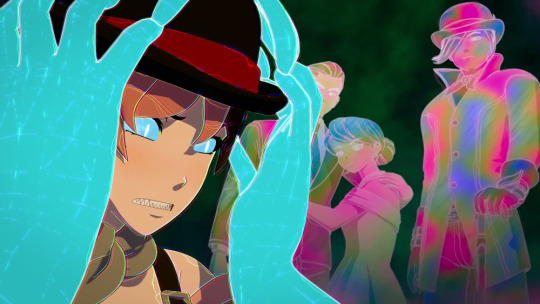
The Tree has the girl confront the pain and grief she has been ignoring. And yet, these feelings are what saves her:
NeoCat: No! These cracks, these feelings! I can’t… I can’t!!!
Thanks to them Neo gets back in control of her life. Symbolically, the Jabberwalker she kills in the beginning appears to finish the Cat off:

In this way, the cycle is complete and Neo's ego can finally surface.
JABBERWOCKY - THE EGO
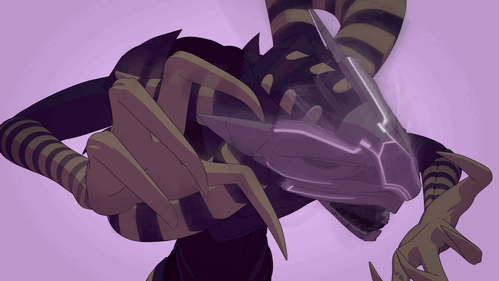
Beware the Jabberwock, my son! The jaws that bite, the claws that catch!
The Jabberwocky is a nonsense poem Alice finds in Through The Looking Glass. She initially can't read it, but then she realizes the verses are written in mirror-writing. She holds a mirror to the text and the poem appears. Despite being able to read it, though, Alice can't understand it:
"It seems very pretty," she said when she had finished it, "but it's rather hard to understand!" (You see she didn't like to confess, even to herself, that she couldn't make it out at all.) "Somehow it seems to fill my head with ideas—only I don't exactly know what they are! However, somebody killed something: that's clear, at any rate."
The poem conveys two main ideas:
It tells about a slaughter:
He took his vorpal sword in hand: Long time the manxome foe he sought— So rested he by the Tumtum tree, And stood awhile in thought. And as in uffish thought he stood, The Jabberwock, with eyes of flame, Came whiffling through the tulgey wood, And burbled as it came! One, two! One, two! And through and through The vorpal blade went snicker-snack! He left it dead, and with its head He went galumphing back.
It is impossible to understand, as it is full of gibberish and invented words
This is true for RWBY's Jabberwalker, as well:
They embody death, as Afterans killed by this creature are negated ascension
They jabber as they walk, which is why they fail to communicate with others
How does this relate to Neo? She kills the Jabberwalker, but assimilates them in her illusions. This happens because the creature is Neo's mirror. They reflect our Hecate in the making.
The Jabberwalker is a monster of grief who dies unheard:
Jabberwalker: Stop… It… Cease! No! NO! NOOOOOO!
Neo is a villain whose grief stays unrecognized:
Ruby: If you’re looking for an apology, you’ve wasted your time!
Not only by others, but by Neo too. She kills a part of herself in the Jabberwalker. Her most vulnerable and real part, that wants to communicate:
Say something real Do you only speak in riddles, chatterbox? I'm waiting for your ugly mouth to Say something real Do you only speak in riddles, chatterbox? I'm waiting on your ugly mouth to spit it out
She is a chatterbox that screams, but is not listened to. She can't talk, then she gains the ability to speak through her semblance. And yet, she can only be heard. Never understood. Similarly, Alice eventually learns how to read the Jabberwocky poem, but doesn't comprehend it.
This is why the Chatterbox song is so mysterious. Is it about Neo? The Cat? Both? Who sings what? Are they singing to each other? Or is it Ruby singing to them? It is impossible to say, just like it is impossible to grasp the full meaning of the Jabberwocky.
So, this song is about Neo and the Cat, but plays while RWBYJ fight the Jabberwalker. That is because the monster represents Neo's frammented self. They are the girl's ego, which is so broken and confused she herself negates it. Her journey in the Ever After, though, helps Neo find inner clarity:
(Waiting for it Sugar-coated All you need is here Come and find what Redefines you Make it crystal clear)
By the end she sees herself crystal clear:
Neo-Roman: To have what they have. What a thing, huh?
Her true wish is the same as ever. She wants a real connection. To succeed she has to let go of an imaginary one:
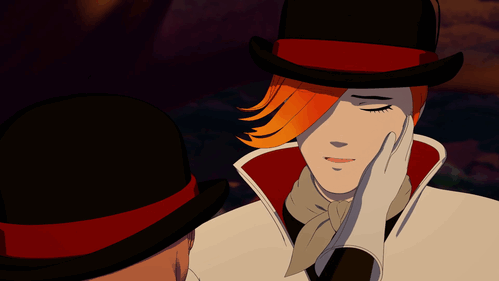
As a child, Trivia lets go of Neopolitan and finds Roman. As an adult, she lets go of Roman to find someone else. Trivia dies and Neo is born. Neo dies and someone new is born:
Blacksmith: She will have the chance to return her broken heart… And becomes something new. Such is balance.
Life from death. Creation from destruction. This is what transformation is. Symbolically, Neo kills all her three parts. She murders the Jabberwalker (ego), she rips the Curious Cat to shreds (superego) and finally releases Roman's illusion (id). Now, she is ready to move on.
HECATE AND ARTEMIS = SHADOW AND LIGHT (MACROCHOSM)

Hecate/Trivia and Artemis/Diana are two intertwined Goddesses. In particular, Hecate is sometimes described as a part of Artemis's triple identity. This Goddess is:
The Moon in the Sky (The Crescent Moon to be precise)
Artemis/Diana on Earth (Goddess of hunt)
Hecate/Trivia in the Underworld
Doesn't it remind you of anyone?

Ruby is
Associated with the Crescent Moon (Crescent Rose)
The best Huntress of all
A Red Grim Reaper with a Scythe
She is the Artemis (Crescent Moon) to Neo's Hecate (Falling Moon). This is why Neo's role in volume 9 is to play Ruby's Jungian Shadow:
In analytical psychology, the shadow is an unconscious aspect of the personality that does not correspond with the ego ideal, leading the ego to resist and project the shadow. In short, the shadow is the self's emotional blind spot, projected as archetypes.
The shadow is everything that is repressed or hidden. In Ruby's case that is her emotions over loss and grief. So, Neo becomes what links Ruby to these feelings of death. Just like Hecate/Trivia is the part of Artemis/Diana, who appears in the Underworld. This is why Neo and Ruby fall together in the Ever After.
During their fall, Neo transforms in three people Ruby cherishes: Oscar, Yang and Penny. What do they represent?
They are linked to future, present and past. In particular, Oscar is waiting for Ruby outside (future), Yang is in the Ever After with Ruby (present) and Penny is lost (past).
They are the three people Ruby's conflict is focused on in the Atlas Arc. In volume 7, Ruby disagrees with Oscar on telling Ironwood. In volume 8, Ruby and Yang fight over what to do. In volume 9, Ruby must overcome Penny's death.
These two meanings are linked to two roles Neo fulfills towards Ruby. That of Triple Goddess and that of Goddess of crossroads.
1- The idea of past, present and future ties into Hecate being a Triple Goddess:
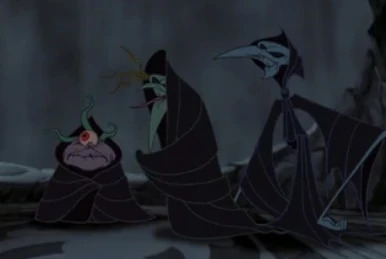
The fates are a representation of this Goddess and a declination of the Three Hecate Sisters, also known as Maiden, Mother and Crone. They are archetypes linked to three different phases of life. Youth, maturity and old age. In other words, past, present and future.
As Ruby's Hecate, Neo often brings up past, present and future throughout volume 9. Here is a quick list:
Ruby and Neo's fall in the Ever After (Penny is past, Yang is present and Oscar is future)
Ruby's first meeting with the Blacksmith, which is followed by the appearance of Neo's Jabberwalkers. There Ruby sees three weapons. Penny's sword is Ruby's inner child (past). Alyx's knife is the role Ruby is currently trying to fulfill (present). Summer's axe is who Ruby wishes to become (future)
Ruby's fight with Neo's Jabberwalker, where Ruby hallucinates three people. Cinder is the foe Ruby lost to (past). Penny is her current inner demon (present). Salem is the villain Ruby must eventually face (future)
Neo's crazy tea party, where Neo destroys Ruby by using three loved ones. Penny is a dead friend (past), Oscar is a friend Ruby could kill (future) and Little is a friend that dies (present)
Past, present and future haunt Ruby, so that she can accept who she was, understand who she is and move towards who she will be:
Past Ruby: So, are you a Huntress? Like the ones you read about in books? Ruby: I… I don’t know… Past Ruby: They always saved the day, didn’t they? Always knew what to do. Always won in the end. Ruby: But… life isn’t like a fairy tale… Past Ruby: That’s right! It’s up to you to make things better, isn’t it? Everything all depends on you! Your sister needs you, your friends need you, the whole world needs you to keep fighting, forever and ever, against an invincible monster that took your mother! Past Ruby: Mom was the best… but even she failed. That doesn’t seem fair. None of this seems fair. Ruby: But… What am I supposed to do…? Past Ruby: You can do whatever you want. Be whoever you want! You don’t even have to be Ruby Rose… So, what are you gonna be?
2- Neo brings to the surface Ruby's inner conflicts. She starts with the three struggles Ruby faces in Atlas and she keeps going by using her Jabberwalkers to re-create Atlas's destruction twice:


Finally, she has Ruby fight her inner demons all at once:
Neo-Ironwood: Who were you to think you knew what was best for Atlas? Neo-Pyrrha: I was the best and brightest Beacon had to offer. But I traded my life so my friends could live! Neo-Penny: Just like you were too late to save me at the Vytal Festival… I died in Atlas too, didn’t I? (walks towards Ruby) Can you imagine what that's like? To be completely and utterly failed… time and again… (kneels down to Ruby) by someone who meant the world to you… Neo-Pyrrha: How many more people are going to die because of you?! Ruby: I’m trying to save everyone! Neo-Ironwood: And yet with all your best intentions… Have you ever stopped to wonder if you’d done more harm than good?! Ruby: It’s not my fault…! Neo-Ozpin: How many more lives do you have to ruin before you realize you’re not cut out to save anyone?! Ruby: NO!!!
This happens because Neo is a manifestation of Ruby's id. Just like Hecate is a Goddess linked with crossroads and choice, Neo forces Ruby to transform.
Ruby's hidden self and her conflictual feelings are intertwined in Neo, who is the part of herself Ruby refuses to aknowledge until it explodes.
Let's juxtapose these two scenes:
Ruby: What is this about? The White Fang? Roman Torchwick?
Ruby: Is that seriously what this is all about? You still blame me for what happened to Torchwick?!
In volume 4, Ruby asks Tyrian why he is after her and mentions Torchwick. In volume 9, Ruby is surprised Roman's partner wants to avenge him. This happens because throughout Mistral and Atlas, Ruby starts shouldering too much responsibilities by herself. Her whole ego becomes intertwined with the duty to stop Salem. By doing so, she neglects other parts of the self:
Maria: You know, you don't give yourself enough credit. Ruby: Oh… Thanks. Maria: That wasn't a compliment.
Which leads to the shadow suffering and festering. Inside Ruby, the shadow is her grief and trauma. Outside, the shadow is Neo. A secondary villain with a revenge agenda, which is nothing compared to the threath Salem represents. And yet, Neo's personal grudge grows until she becomes dangerous for Ruby's own existence:
Neo-Roman: You don’t deserve to die, Red. You deserve to be broken down… Torn apart… wiped from existence.
In this context, Ruby refusing to empathize with Neo is really Ruby refusing to empathize with herself:
Give me anything But this symphony of technicolor rage You call it righteous, meaningful It's anything but love Don't take me for a fool I know this all too well so Leave your tears to someone else cuz It's not just you who lost it all
Neo kills the Jabberwalker because she doesn't want to accept Roman's loss. Ruby doesn't see Neo because it would mean to look at her own pain.
The end result is bad for both girls. On the one hand Ruby is overwhelmed by trauma and chooses to disappear. On the other hand Neo realizes how empty she is after Ruby is gone. That is because shadow and light can't live without each other. They need to integrate, which is what Ruby and Neo do by the end.
Both see themselves more clearly, so they are finally able to empathize with each other:


Their conflict almost kills them, but once they get throught it they are ready to become better versions of themselves. They die and are reborn:

Since she had used her Semblance for the first time to create a butterfly with one pink wing, one brown, with white spots all over- then sent it out her bedroom window and watched it flutter away until she lost sight of it and let it go. (Roman Holiday, chapter 11)
Like two butterflies, who step into a brand new phase of their lives.
HECATE (BALANCE)
Neo's story is about finding balance inside and outside:
Inside- As a child, Neo is too repressed (superego), so as an adult she becomes uncontrolled (id). Her arc has her grow more balanced (ego).
Outside - In volume 9, Neo is Ruby's shadow (id) and brings out all of Ruby's negative emotions. By the end, though, Ruby is able to understand Neo and feels sympathy for her. This is because our LRRH doesn't refuse her own shadow anymore.
In other words, Neo is an id character, who has to integrate both with herself and with the world around her. This fits Hecate, who is a Goddess linked to the Underworld. The Ever After itself is a representation of this kingdom for three different reasons:
It is the world before (under) Remnant
It is the world of the deads (buried under)
It is the world of the unconscious (buried inside)
This is why Neo's semblance grows more powerful while there. Hecate is the queen of ghosts and Neo grows powerful enough to rule the Ever After with her materialized spirits (illusions). On a deeper level, our lady of the deads must face her own grief. So, like other characters, Neo goes through the stages of grief. In particular, Neo's stages are represented by her reactions to different characters:
The Jabberwalker she kills (negation)
Ruby she stalks and tortures (rage)
The Roman she materializes (bargaining)
The Curious Cat she is controlled by (depression)
All these meetings are a part of her journey to find both acceptance and herself. Maybe this is why throughout volume 9 she progressively becomes more and more Hecate-like. As a matter of fact, she aquires many attributes of the mysterious Goddess.
She gains her personal Empusas:

The Empusas are Hecate's demons, who look like girls with some odd body parts. In this case, Neo's heterocromia.
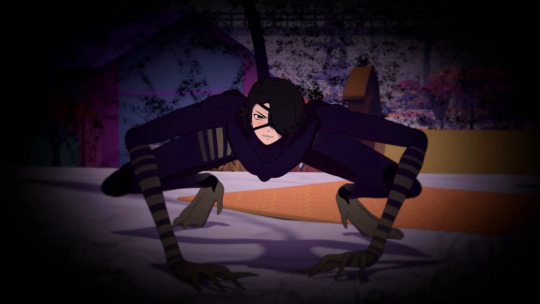
The Empusas are usually monsters linked to fire that appear as half-dogs. Here, Ruby sees the Jabberwalker with Cinder's head.
She finds her own Horned God:
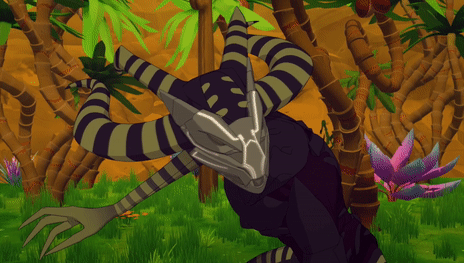
The Horned God is the Triple Goddess's companion in neopagan religions. The Jabberwalker is a horned creature associated with Neo.
She commands a pack of dogs (the Jabberwalkers) and she herself plays the part of Ruby's dangerous wolf. This fits with Hecate's sacred animals being dogs.
Finally, she stands beside a wicked torch:
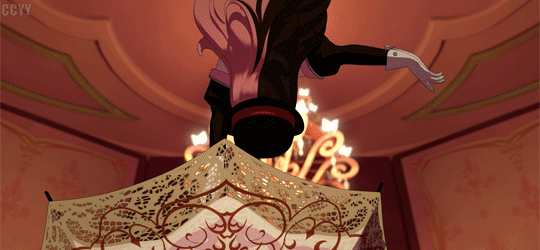
Torchwick-illusion is her companion in the Underworld and a symbol of her friend's lost soul. She even uses Roman's voice to lead Ruby towards death. Just like Hecate holds torches to guide mortals in the Kingdom of the Deads.
Despite all this, there is still an attribute missing: keys. They represent Hecate's ability to travel through worlds. However, Neo is stuck in the Ever After:
Jaune: So Neo can’t go through the door…
This happens because she has still to fully bloom into Hecate (herself). However, she is making progress and by the end of volume 9 she reaches acceptance. A necessary step to grow.
In particular, she dispels her illusion of Roman. She overcomes her grief by overcoming her own fantasies. This is interesting because it is the opposite of what happens in Roman Holiday:
“He caught a lock of her hair and showed it to her. It was white. “This is new. It suits you,” he said. Why would she have done that with her Semblance?” (Roman Holiday, chapter 26)
There, she represses her sadness over her parents' death, which manifests in her illusory white lock of hair. In the series, though, she lets go of an illusion to move on. Why is that so? That is because Neo herself is a combination of illusion and reality:
“Roman shook his head. “Show them who you really are.” Neo changed back into herself, but swapper her school uniform for her favourite suite. Roman handed her her parasol. (Roman Holiday, chapter 22)
Roman Holiday is the story of how she realizes illusions are a part of who she is. Volume 9 is where she learns she can't live in a world made only of illusions. So, she chooses to face herself for real:
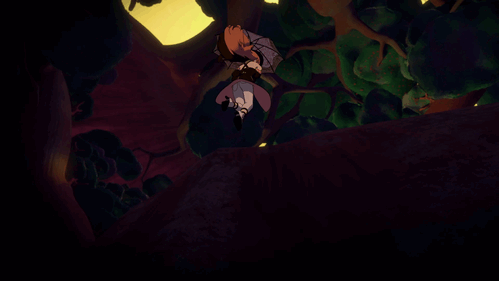
Once she emerges from the Tree, she will gain her allusion's ability to move freely between dimensions (psychopomp) and will go through the door. She will leave her fantastical world (the Ever After) and come back to reality (Remnant).
#rwby#rwby volume 9#rwby meta#neopolitan#neopolitan (rwby)#neo rwby#ruby rose#roman torchwick#curious cat#jabberwalker#once upon an allusion#my meta
238 notes
·
View notes